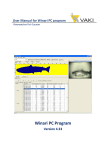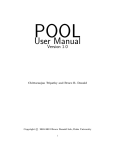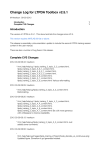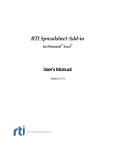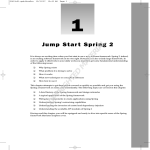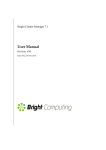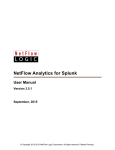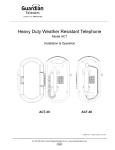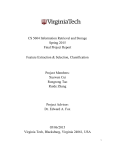Download LDA Report PDF - VTechWorks
Transcript
LDA Team Project in CS5604
Spring 2015
Extracting Topics from Tweets and
Webpages for IDEAL
May 10, 2015
by
Sarunya Pumma and Xiaoyang Liu
LDA Team
Instructor
Prof. Edward Fox
Virginia Tech, Blacksburg, Virginia
Abstract
IDEAL or Integrated Digital Event Archiving and Library is a project of Virginia Tech to implement
the state-of-the-art event-based information retrieval system. A practice project of CS 5604
Information Retrieval is a part of the IDEAL project. The main objective of this project is to build
a robust search engine on top of Solr, a general purpose open-source search engine, and
Hadoop, a big data processing platform. The search engine can provide a set of documents,
which are tweets and webpages, that is relevant to a query word that a user provides. To
enhance the performance of the search engine, the documents in the archive have been
indexed by various approaches including LDA (Latent Dirichlet Allocation), NER (Name-Entity
Recognition), Clustering, Classification, and Social Network Analysis. As CS 5604 is a problembased learning class, an implementation and a development of each technique has been
assigned to each team in the class. In this report, the implementation of the LDA component is
presented. LDA is responsible for extracting collections of topics from the documents. A topic in
this context is a set of words that can be used to represent a document. We introduce
background knowledge, design, tutorial for related packages, results and evaluation. The results
are got from both tweet and webpages collections. And evaluation part contains different
method to evaluate the performance of LDA. Based on the result and background knowledge,
we give a conclusion of our work. Also a user manual and a developer manual are presented for
readers. Contents
1. Introduction .............................................................................................................................6
2. Background Knowledge and Literature Review ......................................................................8
2.1. Important Chapters of the Textbook for Our Team ............................................................8
2.2. Literature Review ..............................................................................................................9
3. Work Plan and Deliverables .................................................................................................14
3.1. Overall Plan ....................................................................................................................14
3.2. Deliverables ....................................................................................................................15
4. Requirements .......................................................................................................................16
4.1. Information Retrieval System Overview ..........................................................................16
4.2. LDA Component Functional Requirements .....................................................................17
4.3. Analysis of Inter-Dependencies between Teams ............................................................18
5. Detailed Design ....................................................................................................................20
6. Implementation .......................................................................................................................22
6.1. Input Data Preprocessing ...............................................................................................22
6.1.1. Tweets Preprocessing..............................................................................................22
6.1.2. Webpages Preprocessing ........................................................................................23
6.2. LDA processing ...............................................................................................................24
6.2.1. Invoking LDA from Java ...........................................................................................24
6.2.2. Selection of Number of Topics .................................................................................26
6.2.2.1. Empirical Study For A Small Tweet Collection ................................................27
6.2.2.2. Empirical Study For A Big Tweet Collection....................................................28
6.2.2.3. Empirical Study For A Small Webpage Collection ..........................................29
6.3. Output Data Storing ........................................................................................................30
7. LDA Evaluation .......................................................................................................................32
7.1. Human Judgement .........................................................................................................32
7.1.1. Word Intrusion ..........................................................................................................32
7.1.2. Topic Intrusion ..........................................................................................................32
7.1.3. Evaluation Result .....................................................................................................33
7.2. Cross-Validation with the Clustering Team......................................................................34
8. Topics for All Collections .........................................................................................................37
8.1. Jan 25 .............................................................................................................................38
8.2. Charlie Hebdo .................................................................................................................38
3
8.3. Ebola ...............................................................................................................................39
8.4. Election ...........................................................................................................................39
8.5. Plane Crash ....................................................................................................................40
8.6. Suicide Bomb Attack .......................................................................................................40
8.7. Winter Storm ...................................................................................................................41
8.8. Malaysia Airlines .............................................................................................................41
8.9. Bomb ...............................................................................................................................42
8.10. Diabetes ..........................................................................................................................42
8.11. Egypt ...............................................................................................................................43
8.12. Shooting ..........................................................................................................................43
8.13. Storm ..............................................................................................................................44
8.14. Tunisia.............................................................................................................................44
8.15. Conclusion ......................................................................................................................45
9. User Manual .........................................................................................................................45
9.1. Basic HDFS Usage .........................................................................................................45
9.2. Compile and Run the Hadoop Program to Convert AVRO/Text File to Sequence File/Text
File ..................................................................................................................................45
9.3. Compile and Run the Hadoop Program to Invoke LDA ..................................................50
9.4. Read AVRO File ..............................................................................................................57
10. Developers manual ...............................................................................................................59
10.1.Solr Installation ................................................................................................................59
10.2. Importing Example Documents to Solr ...........................................................................60
10.3. Crawling Web Contents using Python Script ..................................................................63
10.4. Hadoop Installation .........................................................................................................64
10.4.1.SSH Access Set Up .................................................................................................64
10.4.2.Hadoop Installation .................................................................................................64
10.5. Mahout Installation ..........................................................................................................67
10.6. Nutch Installation and Tutorial .........................................................................................67
10.7. Crawl Webpages from Small Collection of Tweets .........................................................68
11. Conclusion ............................................................................................................................70
12. Acknowledgements ..............................................................................................................70
13. References ...........................................................................................................................71
4
14. Appendix ...............................................................................................................................73
14.1. Appendix A: Questionnaire .............................................................................................73
5
1. Introduction
This report is part of CS 5604 Information Retrieval, of which the purpose is to design and
construct a robust search engine based on Solr. Our team focuses on the application of LDA to
extract topics from tweets and webpages. In this report, background knowledge is presented in
section 2. 2.1 is information about related chapters in the textbook and 2.2 is a literature review,
which includes most important knowledge based on several papers related to LDA. In
requirements section, We introduce the relationship between our team and other teams. 4.1 is
the overview of the whole system and 4.2 is about LDA component. Inter-Dependencies are
presented in 4.3 to give information about the cooperation. Detailed Design of LDA is discussed
in section 5, which contains the our design for the LDA component. Based on the knowledge of
the chapters talked above, we present implementation in section 6. 6.1 is about input data
preprocessing, which includes the preprocessing of both tweet and webpage collections. 6.2 is
about LDA processing. In this section, we present a Java program in 6.2.1 to evoke LDA more
easily. Several empirical studies on different collections are given in 6.2.2 to find the best
number of topics. 6.3 is introduced for output data storing. After getting results from LDA, we
introduce two evaluation method to evaluate the performance of our LDA. 7.1 is talking about
evaluation based on human judgement and 7.2 is cross-validation with the Clustering Team. In
section 8, we present the results of different collections and a conclusion based on these
results. From the conclusion, reader can easily find the work we haven’t finished yet. A user
manual and a developer manual are also included in this report. In the user manual section, we
discuss necessary knowledge for using LDA component. This knowledge contains basic HDFS
usage, convert file formats, invoke LDA methods and method to read a specific type of file,
AVRO. Section 10 is Developer manual. In this section, we present required information for
construct a LDA component based on our experience. It includes Solr installation and a simple
tutorial for importing example documents to Solr, which is in 10.1 and 10.2. 10.3 talks about
crawling webpages using Python script, and 10.6 provides another method Nutch to crawl
webpages. We also introduce an example of crawling webpages from small collection of tweets.
10.5 is about package Mahout, we presents a procedure for installation and a tutorial for using
Mahout LDA.
This report contains three parts. Firstly, a literature review and related references are provided
for readers to understand the algorithm of LDA and if needed, to know more details about the
LDA model. Secondly, we give the overview of our work. From this part, readers will have an
overall knowledge of our work to understand the function of LDA in the whole project and know
the relations and inter-dependencies between our team and other teams, such as the Solr team.
Finally, we describe details of the work, which include installations of certain packages, methods
for applying LDA in Mahout and indexing data and the detailed design of our team’s project.
Also, a user manual and a developer manual are provided in this report to help people, who
want to work on the same project, to get started quickly.
6
Overall, this report includes almost all the information about the LDA application to construct a
search engine based on Solr. We hope the content in this report is beneficial to readers.
7
2. Background Knowledge and Literature Review
This section provides background knowledge and literature review for LDA.
2.1. Important Chapters of the Textbook for Our Team
According to the tasks mentioned above, the related chapters are Chapter 6, Chapter 7,
Chapter 8, and Chapter 18. Among them, Chapter 6 and Chapter 7 are the most important
chapters.
Since TF-IDF is a fundamental weight used in general information retrieval systems, we are
required to understand the basic knowledge about it. Chapter 6, which is “scoring, term
weighting and the vector space model”, talks about this. Studying this chapter will give us an
idea about the importance of document indexing and scoring, for example, the importance of the
TF-IDF weight. In Chapter 6, there are three important topics that we are certain will be useful
for our work. The first one is parametric and zone indexes which will allow us to index and rank
the documents in response to the query. The second one is the idea of weighting the
importance of a term in a document. The third one is about the vector space model, which is a
fundamental of information retrieval operations ranging from scoring documents based on a
query, document classification to document clustering. Similar to Chapter 6, Chapter 7 gives
details of the advanced scoring and ranking methods. Understanding the techniques that are
described in this chapter will help us to create an efficient scoring and ranking method based on
LDA.
Moreover, we need to learn more about LDA. Although this textbook does not provide much
detail about LDA, it provides useful references to study extensively. Since LDA is an initial
probabilistic extension of the latent semantic indexing (LSI) technique, it is necessary for our
team to review Chapter 18, especially the LSI part.
In order to evaluate our LDA system, we need to study the evaluation methods from Chapter 8.
This chapter provides many methods for evaluating different kinds of information retrieval
system.
The following is the list of papers and websites that we are going to study:
Papers
1. Latent Dirichlet allocation [1]
2. LDA-based document models for ad-hoc retrieval [2]
3. Solr's reference guide [3]
Websites
1. Lucene [4]
8
Books
1. Pattern Recognition and Machine Learning [6]
2. An Introduction to Information Retrieval [7]
We also need to read the BodyOfKnowledge in order to understand more about LDA, especially
Section 5: Topic. Section 5 gives the general idea of LDA and useful references that we should
read including:
1. Topic Discovery through Data Dependent and Random Projections [11]
2. Topic discovery based on text mining technique [12]
3. Topic Discovery, Tracking, and Characterization of Social Media Conversation [13]
4. Towards an NLP-Based Topic Characterization of Social Relations [14]
2.2. Literature Review
Latent Dirichlet allocation (LDA) is a model that allows sets of observations to be explained by
unobserved groups that can represent the similarity of the data. For example, in the case that
an observation is a collection of words in a document, LDA extracts a set of words that are likely
to be able to describe the document and uses this set of words to represent the document [8].
The first and most important paper about LDA is “Latent Dirichlet Allocation”, which is written by
David M. Blei, Andrew Y. Ng and Michael I. Jordan. However, it is not straightforward and
actually hard to be understood by beginners. It is necessary to read papers and books to know
the background of LDA since LDA, in general, is a topic model. So the first thing for us is to
know more about topic model and what LDA will do as a topic model.
A topic model is a mixture idea from computer science, mathematics and other fields, which
uses Bayesian statistics and machine learning to discover the latent, or hidden, structure in
given documents and build the links between documents [4]. Then based on this knowledge,
topic models can also give predictions on future documents. Because of these, topic models are
powerful tools, which are used to understand information that seems not related to each other
and even chaotic. LDA is an outstanding one in the family of topic models. And how does LDA
work? In general, LDA gives two probability distributions. One is the probability distribution over
words in the same topic and another is the probability distribution over topics in the document.
For example, in the topic of “sports”, there will be some words, such as “football”, “basketball”,
“soccer”, occur together frequently, and then LDA gives the probability distribution over these
words. Also, by examining the documents, one document can be said as 100% about “sports” or
50% about “sports” and 50% about “politics”.
9
In more detail, the algorithm of LDA can be illustrated in words. LDA represents documents as
mixtures of topics that spit out words with certain probabilities. It assumes that documents are
produced in the following way:
• Decide on the number of words N the document will have (say, according to a Poisson
distribution).
• Choose a topic mixture for the document (according to a Dirichlet distribution over a fixed
set of K topics).
• Generate each word w_i in the document by:
1. Picking a topic (according to the multinomial distribution that you sampled above).
2. Using the topic to generate the word itself (according to the topic’s multinomial
distribution).
It is obvious that LDA has a three-layer structure: words -> topics -> documents. From
documents to topics, it follows the Dirichlet distribution. From topics to words, it follows the
multinomial distribution [9].
Before giving the model of Blei’s paper, we also need to illustrate two things. One is Bayesian
statistics. The most important thing about the Bayesian method is the way of thinking, which is a
little different from common sense. It can be described as following:
prior distribution π(θ)+ sample information X => Posterior distribution π(θ|x)
It tells us the observed sample information will update the knowledge we have for the objects.
To be specific, the information will correct the value of parameter θ. It is the process of machine
learning for LDA.
The other is the pLSA (Probabilistic latent semantic analysis) model. It can be described in
Figure 1.
We have a deterministic topic distribution: {education:0.5, economy: 0.3, transportation: 0.2},
and for each topic we have a deterministic distribution over words, for example, education
{university: 0.5, professor: 0.3, course: 0.2}. To get one word for the document, we choose one
topic for the topic distribution and then from this topic we choose one word. Repeating this
process for N times, we can get an N words document.
10
education
economy
transportation
topics k=3
20%
50%
30%
words for each topics w=3
university
professor
course
20%
30%
40%
50%
30%
30%
10%
30%
car
train
plane
60%
market
finance
corportation
FIGURE 1 PLSA
Now it is the right time to talk about the exact LDA model in Blei’s paper. Actually, the LDA
model is the combination of pLSA model and Bayesian statistics. In the paper “Latent Dirichlet
Allocation” [10], the authors give the LDA model using the mathematical and graphic model as
shown in Figure 2.
α
θ
β
φ
z
ω
N
FIGURE 2 GRAPHICAL MODEL REPRESENTATION OF LDA. THE BOXES ARE
“PLATES” REPRESENTING REPLICATES.[1]
11
M
The outer plate represents documents, while the inner plate represents the repeated choice of
topics and words within a document
As a mathematical model, LDA assumes the following generative process for each document w
in a corpus D:
1. Choose N ∼ Poisson(ξ).
2. Choose θ ∼ Dir(α).
3. For each of the N words wn:
A. Choose a topic zn ∼ Multinomial(θ).
B. Choose a word wn from p(wn|zn,β), a multinomial probability conditioned on the
topic.
It is obvious that we get the LDA model by applying Bayesian statistics on the pLSA model. The
only difference is that in the pLSA model, the probability distribution of topics and the probability
distribution of words for each topic are determined. But in the LDA model, the distributions are
not determined and follow the Dirichlet Distribution. The process is shown in Figure 3.
!
FIGURE 3 BAYESIAN STATISTICS ON PLSA MODEL
Now we have given the process for forming a document using LDA. However, we can think in
another way because documents and words are obvious and topics are not. So how can we
infer the topics from given documents and words? We will talk about this later.
12
Now, we think in another way. The article is here and how can we know the distribution of topics
and the distribution of words in a particular topic. What we need to do is to estimate the two
arguments in LDA model. There are different ways to calculate arguments of Φ and Θ. Among
them, we want to talk a little about Gibbs Sampling, which is based on Bayesian idea. Gibbs
Sampling algorithm is a little complex in mathematics. But we could illustrate the general idea of
it using a picture.
Z1
Φkt
Θmk
d
Z2
w
…
Zk
FIGURE 4 BAYESIAN STATISTICS ON PLSA MODEL
P(topic|doc) * P(word|topic) is the probability for the way doc—>topic—>word. So k topics are
related to K routes so Gibbs sampling will get samples from these k routes. In this way, by
calculating the Posterior distribution of distributions of topics and words, we successfully know
the distributions of topics and words, which are related to unknown arguments.
In information retrieval, researches have introduced a couple of models solve the classic
problem. Among them, LDA is a successful one and popular these days for its good quality in
extending, good performance and so on. LDA can be extended to be achieved by using another
distribution on the simplex instead of Dirichlet. And it can also be extended to a hierarchical
LDA(hLDA), in which topics are collected together in a hierarchy. The LDA model is a Bayesian
version of pLSA model, which make it has a good performance on small datasets. This
advantage comes from the good quality of Bayesian method that it will not overfit data. And for
big dataset, performances of pLSA and LDA are almost the same. So LDA is widely used
nowadays.
13
3. Work Plan and Deliverables
3.1. Overall Plan
The following Gantt chart shows our work plan for the entire semester. The highlighted blocks in
the chart indicate the amount of time (in weeks) that we require to complete the tasks.
The work plan spans from February to May:
• Week 1 - Week 4 are in February
• Week 5 - Week 9 are in March
• Week 10 - Week 11 are in April
Week
1
Review literature and related documents
Understand the overall information retrieval
system
Install Solr and import tweets and webpages into
Solr
Analyze the LDA component requirements
Design the LDA component
Study tools and library that can be used to
implement the LDA component
Use the tool/library to implement the LDA
component (separate from Solr). Write Java code
to run LDA on Mahout
Test the LDA component (unit testing)
Fix the problems found in testing
Collaborate with the Solr and Hadoop teams to
integrate the LDA component in Solr
Test the LDA component after integrated in Solr
Fix the problems found in testing
Evaluate the quality of LDA
Present the final system
Submit the final report and all deliverables
14
2
3
4
5
6
7
8
9
10 11 12
3.2. Deliverables
The deliverables of our project are as follows:
Due Date
Deliverable
Weekly
Weekly report
March
Midterm presentation
April
Final presentation
May
Final report
May
The LDA component integrated with Solr
15
4. Requirements
This section provides the detailed requirements of the LDA component. The first subsection
describes the details of the overall information retrieval system and shows where the LDA
component will fit into the big picture. The second subsection provides the functional
requirements of the LDA component. The third subsection analyzed the inter-dependencies
between our team and other teams. The last subsection shows the deliverables and a work
plan.
4.1. Information Retrieval System Overview
The highest goal of the Information Retrieval class is to build a robust search system in support
of the Integrated Digital Event Archiving and Library (IDEAL) project. Every team in the class
works in collaboration with each other to implement this innovative information retrieval system.
Similar to Google, this system will allow users to search for documents that relate to events of
interest using query strings. The documents in this context are tweets and webpages.
The search engine for the IDEAL project will be built on top of Solr, an open source search
engine. Moreover, Solr will run on Hadoop, a big data processing platform, in order to accelerate
searching performance. To allow the users to efficiently search for the required documents
based on the events, various classification and clustering technique including LDA, NER, Noise
Reduction, Classifying Types, Extraction & Feature Selection, Clustering, and Social Network
Analysis, will be integrated in the system.
____
____
____
____
____
____
____
____
____
LDA
LDA Features
Vector
Other
Components
Other Features
Vector
Preprocessing
Documents
____
____
____
Query String
from a User
LDA
LDA Features
Vector
Other
Components
Other Features
Vector
Documents
Ranking
Query Time
1) Document1
2) Document2
.
.
n) Documentn
Ranked Documents
FIGURE 5 THE INTEGRATION OF LDA IN SOLR
Our work focuses on the LDA component in this information retrieval system. Latent Dirichlet
Allocation or LDA is an algorithm that provides the set of topics for the given input documents
16
and determines the topic distribution for each document. In our work, the LDA component will be
integrated in Solr as shown in Figure 5.
Figure 5 illustrates the workflow of the overall information retrieval system. The flow can be
divided into 2 major parts: preprocessing and query time processing. The preprocessing phase
performs before query time processing takes place. The preprocessing phase can be
considered as offline processing, while the query time processing is online processing.
In the preprocessing phase, the system takes the documents (tweets and webpages) as the
input and creates features vectors (i.e., LDA features vector) using LDA and other components
(original Solr scoring, NER, Classifying Types, Extraction & Feature Selection, Clustering, and
Social Network Analysis). These features vectors will be stored in the Solr database and will be
used further in the query time processing.
The query time processing occurs when a user performs searching. The query string from the
user will be used to create the feature vectors as in the preprocessing phase. Then the vectors
from this step will be compared to the preprocessed vectors of each document in order to
evaluate the importance of the document. The documents will be ranked based on their
importance. Then, the documents with high importance will be shown to the user.
4.2. LDA Component Functional Requirements
_____
_____
_____
_____
_____
____
_____
____
____
Documents
_____
_____
____
Topic1 { Word1 Word2 Word3 }: ProbT1
Topic2 { Word1 Word2 Word3 }: ProbT2
Topic3 { Word1 Word2 Word3 }: ProbT3
_____
_____
____
Topic1 { Word1 Word2 Word3 }: ProbT1
Topic2 { Word1 Word2 Word3 }: ProbT2
Topic3 { Word1 Word2 Word3 }: ProbT3
Topic Distribution
LDA
Topic1
Topic2
Word1
Word2
Word3
ProbW1
ProbW2
ProbW3
Word1
Word2
Word3
ProbW1
ProbW2
ProbW3
Document Distribution
FIGURE 6 INPUT AND OUTPUT OF LDA
17
LDA processes tweets and webpages in order to find the topic distribution for each document
and also the document distribution for each topic. Figure 6 shows the results from LDA after
processing the documents.
The input of LDA is a set of documents (both tweets and webpages). Our LDA component is
required to process the documents and produce the following outputs:
1. Topic distribution: LDA uses probability value (ProbTn in Figure 6) to indicate the
importance of topics in the document (each topic consists of words {Word1 Word2 Word3}
in Figure 6). The topic distribution is one of the features of the document.
2. Word distribution: each topic will contain different words. The probability value (ProbWn in
Figure 6) will be assigned to each word in order to show the importance of the word to
the topic.
4.3. Analysis of Inter-Dependencies between Teams
In this section, we present the inter-dependencies between the teams in the CS5604 class. The
dependencies are presented in Figure 7.
*
______
______
______
1
______
______
______
3
Tweets
URLs
2
Nutch
*
*
______
______
______
Noise
Reduction
Cleaned
Tweets
______
______
______
*
______
______
______
Cleaned
Webpages
4
Classification
Clustering
LDA
NER
Indexing
5
Webpages
HBase
6
FIGURE 7 INTERDEPENDENCIES BETWEEN TEAMS (THE FILES WITH YELLOW STAR ARE STORED ON HDFS)
18
Solr
From Figure 7, we will describe the dependencies based on the numbers that labeled in the
diagram. Notice that tweets, webpages, cleaned tweets, and cleaned webpages are stored on
HDFS (Note that the files are marked with the yellow star in the diagram).
1. The URLs of webpages are extracted from the tweets by using the Python script from the
TA. The script gets the short URLs and convert them to the original URLs. The list of URLs
is contained in the simple text file.
2. The obtained URLs from the tweets are fed to Apache Nutch, a powerful web crawler, in
order to get the contents of the webpages.
3. The tweets and webpages are cleaned by using the script provided by the noise reducing
team. As of now, we are going to follow the steps in the user manual of the noise reducing
team’s report in order to clean our small and large collections.
4. The cleaned tweets will be fetched from HDFS and indexed by the classification team, the
clustering team, the NER team and our team.
• The clustering team will group the documents into clusters in order to improve searching
performance. The technique that they will use is the top-down clustering approach.
• The classification team will apply some techniques to extract the important features from
the tweets and webpages. Then, they will categorize the data into the predefined
categories based on the extracted features from the previous step. These categories will
be additional metadata which can efficiently improve a query process.
• The NER team will be responsible for extracting the entities from the documents and
classifying them into predefined categories. Once they successfully classify the
documents, the classes will become important metadata in the query process.
• Our team is responsible to extract the topics from the tweets and webpages. Thus, we
can
5. For our team, after getting the extracted topics, we have to store the topics and the
document-topic distribution in HBase. The Hadoop team is responsible for creating the
schema and the script to upload the data to HBase. In the next few weeks, we will need to
consult this team in order to import our output to HBase.
6. The Solr team works in collaboration with the Hadoop team to design the HBase schema.
Therefore, we also need help from the Solr team in order to import/export the data to/from
HBase.
19
5. Detailed Design
This section explains a relationship between major elements of the LDA component. LDA can
be broken down into 3 main parts: data preparation, topics extraction, and data storing. The
relationship between the components can be simply represented in Figure 8.
3
2
1
Topic Extraction
Data Preparation
Data Storing
Mahout
4
HBase
Hadoop & HDFS
x
represents data entity (input/output)
FIGURE 8 ARCHITECTURE OF LDA
The input and output of each part are shown in Table 1.
TABLE 1 INPUT AND OUTPUT OF EACH COMPONENT IN LDA
Data
No.
Data Name
Data Type
Location
1
1. Cleaned tweets
2. Cleaned webpages
AVRO
HDFS
2
1. Tweets
2. Webpages
Sequence file
HDFS
3
1. Document-Topic distribution AVRO
2. Topic-Word distribution
Local Storage
4
1. Document-Topic distribution See HBase schema
2. Topic-Word distribution
HBase
According to Figure 8 and Table 1, the task of each component is as follow:
• Data preparation converts the cleaned tweets and webpages in the AVRO format (data
no. 1) to the sequence file (data no. 2). Notice that these files are stored in HDFS.
• Topic extraction employs CVB (Collapsed Variational Bayesian) on Mahout to get a
collection of topics from the documents. The inputs of this component is the sequence
20
file. The output from this module are topic and word distributions, which are stored in the
AVRO format. The output files are stored in a local storage temporarily.
• Data storing reads the output files from the topic extraction module and stores them to
HBase. As we talked to the Hadoop team, we will use JSON as our data-exchange
format. Therefore, the JSON schema for LDA output as shown as follows:
{
“type”: “array”,
“items”: [{
“words”: {“type”: “array of strings”}
“prob”: {“type”: “number”}
}]
}
JSON schema shown above is associated with only one document. Each item in the
array contains the words in the topic and the probability value of the topic.
The JSON data will be stored in the AVRO file. Then, the AVRO file will be uploaded to
HBase by using the script provided by the Hadoop team
21
6. Implementation
This section presents the implementation of the LDA component.
6.1. Input Data Preprocessing
There are two types of inputs in our work, tweets and webpages. The data preprocessing
methods for tweets and webpages are not the same. Therefore, this subsection is divided into 2
parts, tweets preprocessing and webpages preprocessing.
6.1.1. Tweets Preprocessing
The input data is stored in the AVRO file format. Since LDA on Mahout only accept the
sequence file as the input, we need to convert the AVRO file to the sequence file. We then
implement a Hadoop program to read the tweets from AVRO and create the sequence file.
In order to convert the AVRO file to the sequence file, the schema of the AVRO file is required.
We thus use the schema file (tweets.avsc) of the cleaned tweets provided by the noise
reduction team. The schema is shown in List 1.
LIST 1 CLEANED TWEET SCHEMA
{
"namespace": "cs5604.tweet.NoiseReduction",
"type": “record",
"name": "TweetNoiseReduction",
"fields": [
{"name": "doc_id", "type": "string"},
{"doc": "original", "name": "tweet_id", "type": “string"},
{"doc": "original", "name": "text_clean", "type": “string"},
{"doc": "original", "name": "text_original", "type": "string"},
{"doc": "original", "name": "created_at", "type": “string"},
{"doc": "original", "name": "user_screen_name", "type": “string"},
{"doc": "original", "name": "user_id", "type": “string"},
{"doc": "original", "name": "source", "type": ["string", “null"]},
{“doc": "original", "name": "lang", "type": ["string", “null"]},
{"doc": "original", "name": "favorite_count", "type": ["int",
“null"]},
{"doc": "original", "name": "retweet_count", "type": ["int",
"null"]},
{"doc": "original", "name": "contributors_id", "type": ["string",
"null"]},
{"doc": "original", "name": "coordinates", "type": ["string",
"null"]},
{"doc": "original", "name": "urls", "type": ["string", "null"]},
{"doc": "original", "name": "hashtags", "type": ["string", "null"]},
22
{"doc": "original", "name": "user_mentions_id", "type": ["string",
"null"]},
{"doc": "original", "name": "in_reply_to_user_id", "type":
["string", "null"]},
{"doc": "original", "name": "in_reply_to_status_id", "type":
["string", "null"]}
]
}
From the schema, we use only the text_clean field to produce the sequence file. The program to
convert the AVRO file to the sequence file is shown in List 4, in Section 8.6. The output
sequence file will be used as the input of Mahout LDA.
6.1.2. Webpages Preprocessing
We use the cleaned webpages as the input of LDA. The data is also stored in the AVRO format.
In order to process the webpages using Mahout LDA, we need to convert the AVRO file to the
sequence file. Thus, we use the schema file (webpages.avsc) provided by the noise reduction
team to read the AVRO file. The schema of the cleaned webpages is shown in List 2.
LIST 2 CLEANED WEBPAGE SCHEMA
{
"namespace": “cs5604.webpage.NoiseReduction",
"type": "record",
"name": "WebpageNoiseReduction",
"fields": [
{"name": "doc_id", "type": "string"},
{"doc": "original", "name": "text_clean", "type": ["null",
"string"], "default": null},
{"doc": "original", "name": "text_original", "type": ["null",
"string"], "default": null},
{"doc": "original", "name": "created_at", "type": ["null",
"string"], "default": null},
{"doc": "original", "name": "accessed_at", "type": ["null",
"string"], "default": null},
{"doc": "original", "name": "author", "type": ["null", "string"],
"default": null},
{"doc": "original", "name": "subtitle", "type": ["null", "string"],
"default": null},
{"doc": "original", "name": "section", "type": ["null", "string"],
"default": null},
{"doc": "original", "name": "lang", "type": ["null", "string"],
"default": null},
{"doc": "original", "name": "coordinates", "type": ["null",
"string"], "default": null},
23
{"doc": "original", "name":
"default": null},
{"doc": "original", "name":
"string"], "default": null},
{"doc": "original", "name":
"string"], "default": null},
{"doc": "original", "name":
"string"], "default": null},
{"doc": "original", "name":
"default": null},
{"doc": "original", "name":
"default": null},
{"doc": "original", "name":
"string"], "default": null},
{"doc": "original", "name":
"default": null}
]
"urls", "type": ["null", "string"],
"content_type", "type": ["null",
"text_clean2", "type": ["null",
"collection", "type": ["null",
"title", "type": ["null", "string"],
"url", "type": ["null", "string"],
"appears_in_tweet_ids", "type": ["null",
"domain", "type": ["null", "string"],
}
From the schema, we also use only the text_clean field to produce the sequence file. The
program to convert the AVRO file to the sequence file is shown in List 1, in Section 8.6. The
output sequence file will be used as the input of Mahout LDA as well.
6.2. LDA processing
This section presents the method to invoke Mahout LDA by using a Java program. The method
to choose the number of topics for the data collection is also shown in this section.
6.2.1. Invoking LDA from Java
As mentioned above, we use a Java program to invoke LDA on Mahout. The program performs
the following steps:
1. Convert the sequence file to a sparse vector based on TF-IDF
2. Decompose the vector to the singular value decomposition vectors (SVD vectors)
3. Run CVB algorithm on the SVD vectors
4. Export the document-topic distribution and the topic-words distribution vectors in the text
file format to the local directory
5. Convert the document-topic and the topic-words distributions to the AVRO file
There are 2 products from LDA, the document-topic distribution and the topic-word distribution.
24
Structure of the document-topic distribution
{topic1:P1(topic1),topic2:P1(topic2),…,topicN:P1(topicN)}
.
.
.
{topic1:PX(topic1),topic2:PX(topic2),…,topicN:PX(topicN)}
Note: topicn is topic n
Px(topicn) is a probability value of topic n for document x
N is a number of topics
Structure of the topic-word distribution
{word11:P(word11),word12:P(word12),…,word1M:P(word1M)}
.
.
.
{wordN1:P(wordN1),wordN2:P(wordN2),…,wordNM:P(wordNM)}
Note: wordnm is word m in topic n
P(wordmn) is a probability value of word m in topic n
M is a number of words in each topic
N is a number topics
The following contents are the examples of the document-topic distribution and the topic-word
distribution.
The content of the topic-dist file
{0:0.4653814163484247,0.9:9.909485725912798E-5,00:0.43340406376113655,01:
0.0965042841954036,04:0.004611140837775986}
{0:0.14290405284000532,0.9:1.3330665414191818E-5,00:0.14598699218624975,0
1:0.69797128545587,04:0.013124338852460764}
{0:0.12847616913207754,0.9:0.5656171204828104,00:0.18990642426152174,01:0
.00269070620569358,04:0.11330957991789659}
.
.
The content of the lad-topic file
{election:0.09377751292611668,turnout:0.015083911979021125,kashmir:
0.014100209700970283,early:0.013935142916804111,first:
0.012675928548904244,high:0.011941311072608523,any:
0.010771568993729792,win:0.010105794563938113,other:
0.00958682872066384,must:0.00937156450246399}
{election:0.07178331424599466,you:0.02260734936435454,i:
25
0.015745045166685488,we:0.013520059835565763,about:
0.011924460627230609,all:0.009788375158349343,so:
0.008545898792866836,can:0.007851899797888513,have:
0.007744246542788778,what:0.007070752282093559}
{election:0.07709982543943172,next:0.016222794019969712,day:
0.013913697409794536,up:0.012617008186560684,amp:0.011917249328227677,i:
0.01147080259035411,have:0.00945404960992083,his:
0.009014498875395748,vote:0.007757042413072532,out:0.006882451375573196}
.
.
.
According to the example, the first topic consists of 10 words: election, turnout, kashmir, early,
first, high, any, win, other, and must. The probability of the first topic for the first document is
approximately 0.46 (≈ 0.4653814163484247).
6.2.2. Selection of Number of Topics
The important input parameter of LDA is a number of latent topics for each collection. It is
challenging to select a suitable number of topics for each collection because there are over
million data records for each collection. Since LDA is one of the clustering techniques, the
number of topics is directly related to the number of clusters. If the number of topics is too small,
the documents that are not likely to be in the same group may be forced to be together. If there
are too many topics, strongly related document may be partitioned. In our work, we cluster the
documents based on the top N topics. The documents that have the same top N topics will be
grouped in the same cluster.
To determine the number of topics, we apply an exhaustive method to the small dataset and we
use a heuristic method on the large dataset. We measure the quality of LDA by using KullbackLeibler (KL) divergence. It is the value that measures the similarity between documents based
on their probability distributions. In our work, KL divergence is calculated on the document-topic
distribution matrix. For each cluster, we compute the average of the KL divergence values.
Then, we use the mean of the average KL divergence values to express the clustering quality of
LDA.
KL divergence can be computed as follows:
where P and Q are probabilities
26
If KL divergence is close to zero, documents are similar. Therefore, the more the similarity
between documents, the less KL divergence.
6.2.2.1. Empirical Study For A Small Tweet Collection
We run LDA on the dataset and vary the number of topics from 3 to 20. We also vary a number
of top topics, from 3 to 5. Our approach searches through every variations and select the setting
that gives the best KL divergence.
The results of our empirical study are shown in Figure 9 and Table 2.
3 Top-Topics
0.4
4 Top-Topics
5 Top-Topics
KL Divergence
0.3
0.2
0.1
0
3
4
5
6
7
8
9
10
11
12
13
14
15
16
17
18
Number of Topics
FIGURE 9 EMPIRICAL RESULT OF A SMALL TWEET COLLECTION
27
19
20
TABLE 2 EMPIRICAL RESULT OF A SMALL TWEET COLLECTION
Number of
Topics
Number of Top Topics
3
4
5
3
0.305
-
-
4
0.213
0.284
-
5
0.22
0.271
0.327
6
0.143
0.188
0.236
7
0.148
0.191
0.231
8
0.131
0.166
0.192
9
0.135
0.162
0.189
10
0.114
0.1337
0.159
11
0.107
0.1266
0.146
12
0.108
0.124
0.137
13
0.102
0.121
0.14
14
0.096
0.113
0.13
15
0.091
0.108
0.128
16
0.089
0.104
0.118
17
0.088
0.103
0.12
18
0.087
0.107
0.124
19
0.085
0.105
0.117
20
0.085
0.102
0.119
According to the results, the KL divergence is decreased when the number of topics and the
number of top topics increase. Therefore, the number of top topics that we choose for both
small and big collections is 3 because it can give the best KL divergence value when compare
to other numbers. Although 20 latent topics can give the best KL divergence value, we choose
15 as the number of topics for the small collection because KL divergence does not improve
significantly when the number of topics is over 15.
6.2.2.2. Empirical Study For A Big Tweet Collection
We set the maximum number of topics for the big collections to 50, therefore, the search space
is larger. For this reason, searching through every number of topics will take a long time to
search for the most appropriate setting. We start searching from 3 topics and increase the
number of topics by 3. The result from the empirical study is shown in Figure 10.
28
0.26
KL Divergence
0.195
0.13
0.065
0
3
6
9
12
15
18
21
24
27
30
33
36
39
42
45
48
Number of topics
FIGURE 10 EMPIRICAL RESULT OF A BIG TWEETS COLLECTION
From the graph, the KL divergence value does not improve significantly when the number of
topics is over 15. Therefore, the number of topics for the large data collection that we choose is
15.
6.2.2.3. Empirical Study For A Small Webpage Collection
The empirical study for the small webpage collection is as same as the one for a small tweet
collection. We vary the number of topics from 3 to 20, and we vary the number of top-topics
from 3 to 5. The results are shown in Figure 11 and Table 3.
29
3 Top-Topics
0.3
4 Top-Topics
5 Top-Topics
KL Divergence
0.225
0.15
0.075
0
3
4
5
6
7
8
9
10
11
12
13
14
15
16
17
18
19
20
Number of Topics
FIGURE 11 EMPIRICAL RESULT OF A SMALL WEBPAGE COLLECTION
From Figure 11, the number of topics that we choose for a small webpage collection is 15 and
the number of top-topics is 5 because this setting can give the best KL divergence value.
6.3. Output Data Storing
The output of LDA is stored in the plain text format. In order to upload the output to HBase, we
need to convert the text file to the AVRO file. The following is the schema of the AVRO file
(lda.avsc).
LIST 3 LDA OUTPUT SCHEMA
{
"namespace": "cs5604.tweet.LDA",
"type": "record",
"name": "TweetLDA",
"fields": [
{"name": "doc_id", "type": "string"},
{"doc": "analysis", "name": "lda_topics", "type": ["string", "null"]},
{"doc": "analysis", "name": "lda_vectors", "type": ["string", "null"]}
]
30
}
From the schema, the doc_id field is the ID of the document. This field is associated with the
document ID provided by the noise reduction team.
The lda_topics field stores the topic for the document, which is the combination of words of the
topic with highest probability. The words are separated by a pipe (|);
cat | pet | animal
The lda_vectors field stores the top-three-topic of the document in the JSON string format. The
topics are separated by a pipe (|). The following is the example of the lda_vectors data.
{"words": ["cat", "pet", "animal"], "prob": 0.5} |
{"words": ["dog", "pet", "animal"], "prob": 0.25} | {"words": ["dog", "cute", "animal"], "prob": 0.15}
Notice that the schema of the JSON string is shown in Section 5.
We write a Java program to convert the output data to the AVRO file. The source code is shown
in List 5 in Section 8.7.
To upload the AVRO file to HBase, we use the script provided by the Hadoop team. The name of
the script is hbase-loader.jar (for more information, please refer to the report of the Hadoop
team).
31
7. LDA Evaluation
7.1. Human Judgement
To evaluate LDA topic model, human judgement [16] is an efficient method. Human judgment is
applied by word intrusion task and topic intrusion task. The task of the user is to find the word or
topic which is out of place of doesn’t belong with the others, i.e., the intruder.
The questions in the questionnaire are divided into two parts. One is to select words that are not
closely related with others in the words set of one topic. It is used to evaluate the performance
of extracting words for each topic. Another is to decide whether the words in the set can
describe the topic well based on subjects’ judgement. It is used to evaluate the performance of
extracting topics for the collection.
7.1.1. Word Intrusion
Word intrusion is designed to measure the coherence of topics.We give subject a group of
randomly ordered words. The task of users is to find the word which doesn’t belong with the
others, i.e., the intruder. For example, in the set {dog, cat, horse, apple, pig, cow}, the word
apple will be identified as intruder because all other words are related to animals.
Using the word intrusion method, we could calculate a value from the results of subjects to
estimate LDA model. The formula is shown below[16]:
w (m,k) is the intruding word among the words of k th topic generated by m th model. And
i(m,k,s) is the intruder selected by subject s on the testing set. S is the number of subjects.
7.1.2. Topic Intrusion
Topic intrusion is used to test whether a topic model’s decomposition of document into groups,
which agrees with human judgments of the documents. We use the formula shown below to
calculate the value TLO[16], which is used to estimate the coherence of human judgment and
model results.
The higher the value of TLO, the geater the correspondence between the human judgment and
the model. θ is the possibility of the topic in the documents. Index * means it is the true intruder.
And with the index s, j donate to the intruded topic selected by subjects.
32
7.1.3. Evaluation Result
To do the evaluation based on human judgement, we make a questionnaire that can be found in
the appendix (Appendix A).
The questions in the questionnaire are divided into two parts. One is to select words that are not
closely related with others in the words set of one topic. It is used to evaluate the performance
of extracting words for each topic. Another is to decide whether the words in the set can
describe the topic well based on subjects’ judgement. It is used to evaluate the performance of
extracting topics for the collection.
According to the responses collected, we calculated the value MP. It is around 65%. Actually,
the performance of LDA is good. The relevance of words within a set between human
judgement and results of LDA can be estimated as 65%. In addition, we find a more interesting
conclusion from the data. If we choose first two most frequently selected words for each
question, we can make a table as following:
TABLE 3 FIRST SELECTED WORDS FOR EACH QUESTION
Question
1
2
3
4
5
6
7
8
1
rt
rt
rt
rt
from
rt
rt
rt
2
says
jet
news
after
mh
pic
mh
pic
It is obvious that the word rt is selected in all questions except 5. Because the word set for
question 5 doesn’t contain the word rt. RT at the beginning of a Tweet is to indicate that they
are re-posting someone else's content. So rt shows in tweets very frequently. According to this,
we can make a conclusion that words, which are shown in documents frequently but not related
to the content of the documents will have a lot negative effects on the result calculated from
LDA.
For the second parts of the questionnaire, we make a chart according to the data collected. The
answer Yes means that the set of words calculated from LDA can describe the topic or we
extract the right topic. Answer no is just the opposite. The chart is shown as following:
Yes
No
13%
88%
33
FIGURE 12 THE PROPORTION OF ANSWER YES TO NO
According to the chart, the percentage of getting right topics from LDA is 88%. It means that
88% topics extracted from LDA agree with human judgement.
By comparing the conclusions from these two kinds of questions, we know that the performance
of LDA we used on extracting topics is better than the performance on calculating words for
each topic. For future work, we will focus on improving the performance of extracting words for
each documents using different ways.
7.2. Cross-Validation with the Clustering Team
We compare our clustering results to the clustering team. In this evaluation, the cosine similarity
value is used to measure the similarity of the documents within the same cluster. As same as
the KL divergence, we expect the cosine similarity to be as close to zero as possible. We decide
to do the comparison on the Ebola collection (a small collection) and the Malaysia Airline
collection (a big collection).
To compare our results, we will use t-test, which is a statistical method to compare the means of
two samples. We expect that the quality of LDA clustering is better than the clustering result of
the clustering team, which means our average cosine similarity (μLDA) is lower than the average
cosine similarity of the clustering team (μClustering). Therefore, our hypotheses are as follows:
Null hypothesis (H0): μLDA - μClustering > 0
Alternative hypothesis (H1): μLDA - μClustering < 0
TABLE 4 CROSS VALIDATION RESULTS
34
Ebola Collection
Malaysia Airlines Collection
Run
LDA
Clustering
LDA
Clustering
1
0.0472
0.4293
0.117
0.601
2
0.0475
0.4240
0.140
0.635
3
0.0486
0.4329
0.144
0.632
4
0.0483
0.4374
0.149
0.629
5
0.0501
0.4344
0.133
0.622
6
0.0475
0.3957
0.151
0.621
7
0.0491
0.4257
0.162
0.618
8
0.0466
0.4653
0.133
0.618
9
0.0472
0.4091
0.149
0.634
10
0.0483
0.4397
0.137
0.597
The significant level (α) in our experiment is set to 0.05 (95% confidence interval). We use
Minitab, which is statistical analysis tool, to compute t-test. We can reject the null hypothesis
and accept the alternative hypothesis if p-value is less than the significant level.
The result for the Ebola collection is shown as follows:
Two-sample T for LDA vs Clustering
LDA
Clustering
N
10
10
Mean
0.04804
0.4294
StDev
0.00105
0.0185
SE Mean
0.00033
0.0059
Difference = mu (LDA) - mu (Clustering)
Estimate for difference: -0.38131
95% upper bound for difference: -0.37056
T-Test of difference = 0 (vs <): T-Value = -65.01
P-Value = 0.000
DF = 9
For the Ebola collection, we do not have enough evidence to accept the null hypothesis.
Therefore, we accept the alternative hypothesis, which means LDA has better performance than
the clustering method because the average cosine similarity of LDA is lower than the average
cosine similarity of the clustering approach.
The result for the Malaysia Airlines collection is shown as follows:
Two-sample T for LDA vs Clustering
N
Mean
StDev
SE Mean
35
LDA
Clustering
10
10
0.1415
0.6207
0.0125
0.0131
0.0039
0.0041
Difference = mu (LDA) - mu (Clustering)
Estimate for difference: -0.47920
95% upper bound for difference: -0.46926
T-Test of difference = 0 (vs <): T-Value = -83.83
P-Value = 0.000
DF = 17
For the Malaysia Airlines collection, we do not have a strong evidence to accept the null
hypothesis, thus we reject the null hypothesis and accept the alternative hypothesis. Our
approach also performs better the clustering method.
From the t-test, LDA can outperform the clustering approach. The goal of the LDA team is to
maximize the similarity of the documents within the same group, while the objectives of the
clustering team are both maximizing the similarity of the documents inside the same cluster and
the dissimilarity of the documents in the different groups. Our measurement is somewhat bias
towards LDA because it measures only the similarity of the members in the same cluster. Since
we do not have enough time to do more experiments, we would like to suggest the extensive
work to use a fair-comparison measurement. However, according to the experimental results,
LDA has better performance when maximizing only the similarity of the documents within the
same group. We believe that LDA will still have a comparable performance as the clustering
method.
36
8. Topics for All Collections
We apply LDA to all data collections and the topics for each collection are presented in this
section. Table 5 shows the summary of all collections.
TABLE 5 COLLECTION SUMMARY
Type
Name
Category
File Size
Number of
Tweets
Small
Collection
Jan 25
Revolution/Unrest
220.43 MB
301,605
Charlie Hebdo
Shooting
73.51 MB
173,145
Ebola
Disease
142.94 MB
380,267
Election
Uprising/Election
339.24 MB
829,676
Plan Crash
Accident
104.82 MB
265,999
Suicide Bomb Attack
Bombing
16.61 MB
37,173
Winter Storm
Storm
202.27 MB
485,903
Malaysia Airlines
Accident
320.14 MB
775,411
Bomb
Bombing
6.54 GB
1,776,622
Diabets
Disease
2.07 GB
1,594,337
Egypt
Revolution/Unrest
3.31 GB
2,055,157
Shooting
Shooting
8.40 GB
1,570,190
Storm
Storm
7.60 GB
1,644,525
Tunisia
Uprising/Election
1 GB
1,615,104
Big
Collection
Notice that the collections used in this section are the cleaned collection from the noise
reduction team.
37
8.1. Jan 25
Type: Small
Topics:
["died","martyr","age","gunshot","28","egypt","2","14","mahmoud"]
["egypt","age","6","martyr","30","died","2","gunshot","20","jan28"]
["martyr","egypt","20","today","died","protest","revolution","egyptian","18"]
["martyr","mohamed","died","egypt","amp","age","gunshot","4","today"]
["died","age","martyr","mohamed","gunshot","revolution","2011128","mahmoud","25"]
["martyr","died","25","egypts","police","28","mohamed","25jan","4"]
["30","3","died","amp","today","28","mohamed","2013","22"]
["martyr","amp","mohamed","age","28","3","egyptian","4","military"]
["died","martyr","gunshot","egypt","25","amp","el","square","2011128"]
["25jan","28","egyptian","egypt","amp","died","6april","3","24"]
["died","age","25","revolution","police","6","gunshot","square","people"]
["3","egypt","died","sites","police","unblock","fast","protesters","2"]
["amp","28","unblock","fast","week","2011128","martyr","next","19"]
["3","revolution","sites","fast","10","25jan","unblock","people","18"]
["martyr","age","today","police","3","29","one","egypt","killed"]
8.2. Charlie Hebdo
Type: Small
Topics:
["charlie","hebdo","fired","cartoon","charliehebdo","see","http","basketball","french"]
["charlie","hebdo","attack","new","muslims","paris","http","people","us","cover"]
["hebdo","charlie","cartoons","paris","via","protest","attacks","france","attack"]
["charlie","attack","french","new","hebdo","http","rally","muslim","respond"]
["hebdo","charlie","attack","cartoons","muslims","speech","protest","people","freedom"]
["charlie","hebdo","via","uk","police","french","cartoons","paris","muslim","massacre"]
["charlie","via","attacks","new","france","police","http","french","muslim"]
["hebdo","police","speech","paris","muslims","http","says","religion","british"]
["hebdo","charlie","police","free","new","http","attacks","attack","france"]
["charlie","cartoons","attack","attacks","hebdo","muslims","says","like","police"]
["hebdo","charlie","attacks","paris","free","speech","cartoons","via","muslim"]
["hebdo","charlie","police","muslims","attack","attacks","french","details","names"]
["charlie","hebdo","paris","police","france","attack","muslims","french","killed"]
["police","charlie","hebdo","french","paris","http","via","free","attacks"]
["charlie","hebdo","attack","speech","free","via","police","cover","http"]
38
8.3. Ebola
Type: Small
Topics:
["ebola","outbreak","us","patient","leone","sierra","hospital","africa","says"]
["us","ebola","spread","outbreak","get","medical","scientists","virus","fight"]
["ebola","virus","africa","says","amp","west","liberia","news","patient"]
["ebola","leone","us","doctor","sierra","virus","infected","get","case"]
["ebola","liberia","first","doctor","amp","case","new","cases","get"]
["ebola","via","amp","liberia","us","man","news","im","fight"]
["ebola","virus","outbreak","via","health","infected","us","people","world"]
["ebola","us","liberia","sierra","west","nigeria","wash","doctors","vaccine"]
["ebola","wash","better","195","hiv","sins","via","patient","soap"]
["ebola","west","via","liberia","fight","health","outbreak","nigeria","people"]
["ebola","africa","wash","health","us","news","*profanity*","like","cases"]
["ebola","us","virus","says","get","via","cases","west","fight"]
["africa","outbreak","ebola","first","stop","amp","people","spread","us"]
["sierra","leone","africa","liberia","patient","ebola","outbreak","hospital","via"]
["ebola","outbreak","africa","via","amp","health","spread","like","help"]
8.4. Election
Type: Small
Topics:
["election","reelection","general","labour","would","like","dont","people","news"]
["election","general","2015","win","next","presidential","campaign","via","vote"]
["election","bjp","next","presidential","campaign","votes","2016","one","labour"]
["election","next","vote","presidential","amp","http","dont","results","today"]
["election","amp","win","2015","results","party","jonathan","president","snap"]
["election","new","win","2015","party","labour","via","dont","cameron"]
["election","amp","general","vote","time","2014","elections","2015","won"]
["election","new","us","get","vote","party","2016","2015","want","presidential"]
["election","win","via","2015","http","day","want","campaign","next"]
["election","next","general","amp","http","like","2015","via","greek"]
["election","via","http","like","would","get","win","state","polls"]
["via","general","new","reelection","us","campaign","win","presidential","obama"]
["election","vote","2015","day","general","results","party","dont","one"]
["election","amp","day","vote","via","party","wins","new","delhi"]
[“election","general","voting","delhi","presidential","amp","one","2015","people"]
39
8.5. Plane Crash
Type: Small
Topics:
["crash","plane","killed","everyone","myles","jumps","people","family","bodies"]
["crash","plane","dead","died","near","airport","pilot","today","house","first"]
["crash","family","girl","plane","7yearold","year","dead","7","old"]
["plane","crash","died","taiwan","airasia","found","pilot","dead","engine"]
["plane","crash","airasia","survived","via","girl","died","air","amp"]
["crash","plane","airasia","pilot","flight","died","news","harrison","survivor"]
["plane","crash","via","family","news","pilot","die","flight","video","7yearold"]
["crash","camera","caught","killed","plane","man","ever","survived","managed"]
["plane","crash","dead","killed","die","near","news","bodies","airport"]
["plane","crash","pilot","killed","small","years","airasia","today","caught"]
["crash","plane","killed","survivor","years","old","girl","lost","today"]
["crash","plane","girl","camera","killed","survived","small","caught","family"]
["crash","die","killed","airasia","plane","found","one","flight","new"]
["plane","crash","killed","airasia","girl","via","people","near","pilot"]
["plane","die","ariana","fav","grande","crashes","join","ignore","caught"]
8.6. Suicide Bomb Attack
Type: Small
Topics:
["suicide","attack","car","people","least","bomber","kills","killed","pakistan","baghdad"]
["car","attack","least","killed","bomb","kabul","iraq","afghan","people","suicide"]
["bomb","attack","suicide","dead","killed","pakistan","left","blast","iraq"]
["bomb","attack","people","kills","car","least","afghan","afghanistan","police"]
["attack","suicide","bomb","killed","iraq","church","people","kills","pakistan","funeral"]
["bomb","suicide","attack","kills","killed","iraq","people","afghanistan","kabul"]
["bomb","suicide","killed","dead","kabul","syria","bombing","news","bomber"]
["bomb","attack","car","killed","least","kills","blast","baghdad","amp"]
["bomb","attack","suicide","killed","people","car","kabul","officials","church"]
["bomb","attack","blast","least","rogue","targets","libya","general","car"]
["suicide","bomb","cafe","car","attack","deadly","kills","iraq","police"]
["suicide","attack","killed","pakistan","least","dead","bomb","kabul","church"]
["attack","suicide","bomb","killed","pakistan","least","afghanistan","car","people"]
["suicide","attack","kills","blast","least","bus","afghanistan","afghan","killed"]
["suicide","attack","bomb","kills","car","bomber","afghan","kano","iraq"]
40
8.7. Winter Storm
Type: Small
Topics:
["storm","warning","winter","pm","weather","another","http","new","nws"]
["winter","storm","snow","weather","issued","amp","inches","cold","east","counties"]
["storm","issued","snow","watch","winter","http","counties","warning","est"]
["storm","winter","snow","warning","watch","weather","northeast","another","amp"]
["storm","amp","warning","new","snow","us","ice","effect","morning","southern"]
["winter","storm","warning","est","amp","weather","november","snow","another","pm"]
["storm","est","winter","issued","watch","february","northeast","warning","january"]
["winter","storm","effect","county","warning","weather","new","snow","watch"]
["winter","snow","storm","warning","issued","watch","area","http","nws"]
["winter","storm","warning","issued","snow","february","nws","new","cst"]
["storm","winter","watch","february","weather","amp","northeast","est","major"]
["winter","storm","warning","snow","est","watch","nws","new","issued"]
["winter","storm","issued","watch","snow","nws","november","warning","east"]
["winter","storm","weather","watch","issued","us","amp","morning","mst"]
["storm","winter","watch","new","northeast","est","due","pm","another"]
8.8. Malaysia Airlines
Type: Big
Topics:
["plane","mh370","malaysia","pic","1","missing","found","shocking","update"]
["airlines","search","flight","missing","mh370","crash","australian","says","plane"]
["malaysia","airlines","missing","mh370","search","jet","flight","new","plane"]
["flight","search","malaysia","missing","jet","mh370","plane","shocking","found"]
["search","plane","found","airlines","1","pic","malaysia","new","underwater"]
["airlines","malaysia","flight","missing","news","plane","ukraine","1","mh370"]
["airlines","malaysia","flight","mh370","370","jet","mh17","missing","new"]
["malaysia","airlines","pic","1","found","plane","mh370","flight","missing"]
["malaysia","airlines","flight","missing","mh370","plane","new","crash","found","370"]
["flight","370","malaysia","news","airlines","shocking","ukraine","search","via"]
["airlines","flight","plane","found","search","pic","370","mh17","mh370"]
["airlines","plane","says","malaysia","found","flight","search","1","new"]
["malaysia","airlines","plane","found","1","mh370","pic","flight","bucket"]
["flight","malaysia","airlines","mh370","370","plane","mh17","search","report"]
["malaysia","plane","search","crash","mh370","370","airlines","jet","underwater"]
41
8.9. Bomb
Type: Big
Topics:
["bomb","boston","im","time","love","man","bombing","bombings","suspect"]
["bomb","im","amp","u","time","one","*profanity*","like","us"]
["bomb","*profanity*","da","like","im","got","know","make","day","today"]
["bomb","like","boston","one","da","love","dont","car","man","police"]
["bomb","like","*profanity*","lol","amp","dont","u","dot","com"]
["bomb","boston","lol","time","im","right","marathon","da","*profanity*"]
["bomb","amp","go","u","im","sounds","right","make","threat"]
["amp","love","sex","bombing","got","get","police","threat","*profanity*","lol"]
["bomb","*profanity*","boston","amp","new","got","want","like","sounds"]
["bomb","da","like","im","right","dick","amp","people","get"]
["bomb","like","*profanity*","*profanity*","right","da","lol","af","amp"]
["bomb","boston","bombing","suspect","dont","look","lol","marathon","photo"]
["bomb","boston","*profanity*","like","da","go","say","dick","*profanity*"]
["bomb","boston","bombing","marathon","go","amp","da","lol","suspect"]
["bomb","*profanity*","sounds","boston","time","u","us","man","made"]
8.10. Diabetes
Type: Big
Topics:
["2","type","help","disease","dont","know","health","new","de"]
["diabetes","risk","im","know","chocolate","dont","heart","bill","sweet"]
["diabetes","get","new","risk","people","1","amp","juan","eats"]
["like","know","2","people","risk","get","bars","one","de"]
["sugar","bars","type","one","juan","2","study","may","disease"]
["diabetes","john","type","2","new","day","get","today","w"]
["diabetes","amp","disease","type","blood","help","sugar","risk","im","chocolate"]
["diabetes","get","via","new","disease","sugar","one","diet","study"]
["type","amp","help","2","diabetes","1","people","via","chocolate"]
["diabetes","amp","chocolate","know","im","jim","de","la","type"]
["diabetes","2","risk","type","1","de","people","could","weight"]
["diabetes","type","2","risk","like","day","one","dont","amp"]
["diabetes","type","juan","bars","2","1","eats","chocolate","get"]
["amp","2","cancer","diabetes","heart","weight","type","via","help","like"]
["diabetes","bars","type","jim","45","health","people","cancer","eats"]
42
8.11. Egypt
Type: Big
Topics:
["new","today","http","iran","25jan","political","free","5","two"]
["2011","via","news","state","people","2","5","president","one"]
["25jan","us","2","amp","political","news","new","protest","egyptian"]
["egypt","us","military","amp","6","president","killed","people","protest"]
["brotherhood","muslim","says","free","human","cairo","http","military","killed"]
["3","amp","egypt","2011","egyptian","via","http","4","killed"]
["police","http","killed","support","one","watch","people","day","muslim"]
["egypt","25jan","via","us","coup","6","muslim","new","protesters"]
["president","people","egypt","http","morsi","army","al","news","military"]
["says","new","2","via","people","egypt","time","amp","iran","4"]
["egypt","3","2011","amp","coup","military","live","army","egyptian"]
["amp","egyptian","via","new","2","brotherhood","us","protest","police"]
["2011","today","amp","via","says","25jan","military","day","egyptian"]
["amp","via","http","police","people","4","us","cairo","6"]
["amp","egyptian","military","muslim","brotherhood","security","protesters","people","army"]
8.12. Shooting
Type: Big
Topics:
["shooting","police","school","people","high","video","shot","3","two"]
["shooting","like","star","people","police","saw","3","im","today"]
["shooting","school","day","police","game","time","dont","going","suspect"]
["school","amp","police","one","gun","like","star","niggas","3"]
["shooting","school","time","video","today","day","man","suspect","first","people"]
["shooting","gun","star","police","amp","go","today","new","like"]
["shooting","video","im","like","one","day","amp","2","get"]
["shooting","amp","star","new","day","u","like","today","one"]
["im","police","today","shooting","dont","dead","video","time","last"]
["shooting","amp","night","stars","today","video","people","3","day"]
["shooting","like","stars","video","man","amp","first","police","im"]
["shooting","today","video","like","new","music","people","good","star"]
["shooting","star","stars","one","killed","2","man","school","dont"]
["shooting","im","video","new","stars","star","amp","time","man"]
["shooting","im","man","go","night","one","dont","new","see","like"]
43
8.13. Storm
Type: Big
Topics:
["storm","thunder","im","snow","coming","got","get","winter","us"]
["storm","like","us","amp","nothing","rain","new","im","together","life"]
["storm","tropical","go","perfect","im","right","ill","via","night","http"]
["storm","snow","like","calm","us","new","get","winter","right"]
["storm","every","rain","like","runs","calm","away","snow","big"]
["storm","rain","get","winter","amp","day","night","calm","snow"]
["storm","us","winter","amp","one","via","night","weather","tropical"]
["storm","im","new","day","weather","get","last","cant","would"]
["like","snow","day","cant","weather","tornado","one","night","tweet"]
["storm","snow","rain","dance","amp","life","pass","learning","waiting"]
["storm","know","dont","lol","severe","perfect","every","day","hope"]
["storm","like","rain","winter","dont","warning","get","go","cant"]
["storm","weather","snow","amp","know","dont","im","rain","today"]
["storm","like","winter","coming","calm","today","ice","god","snow"]
[“storm","im","every","love","life","waiting","going","snow","see"]
8.14. Tunisia
Type: Big
Topics:
["tsunami","one","wave","distance","japan","100","day","miles","lol"]
["tsunami","like","amp","warning","m","via","hit","lol","new"]
["tsunami","get","greater","undersea","like","earthquake","dont","devastating","lol"]
["tsunami","japan","got","de","today","like","separated","would","make"]
["m","warning","amp","like","im","california","2014","earthquake","gmt"]
["tsunami","like","earthquake","japan","via","clouds","coming","old","one"]
["tsunami","amp","di","warning","aceh","quake","video","japan","lol","tahun"]
["tsunami","greater","power","whack","warning","creation","devastating","led","get"]
["tsunami","new","get","dont","5","like","quake","tides","di"]
["tsunami","eyes","tides","waves","like","theyre","anymore","missing","dont"]
["tsunami","get","like","dont","tides","missing","anymore","waves","eyes","theyre"]
["tsunami","im","like","get","japan","tortoise","family","make","dont","friend"]
["tsunami","got","amp","best","japan","baby","friend","year","hippo"]
["tsunami","baby","year","new","tortoise","old","hippo","friend","like"]
[“tsunami”,"like","warning","di","japan","im","m","get","alaska"]
44
8.15. Conclusion
Based on the results presented above, we can see that LDA works well for most time.
And topics extracted from documents are coherent with human judgement. However,
there are some problem we need to deal with. One is that there are sometimes some
unrelated words in a word set of a topic. These words are frequency words that are not
related to a topic. We need to find ways to get rid of the influence of this kind of words.
Another is to find a reliable method to find the best number of topics in a documents and
number of words to present a topic.
9. User Manual
This section demonstrates how to use HDFS (Hadoop Distributed File System) and Mahout’s
LDA.
9.1. Basic HDFS Usage
HDFS is a part of Hadoop. It is a distributed file system used for distributing files across
machines in a Hadoop cluster. HDFS (for Hadoop version 1.2.1) can be invoked using the
command hadoop fs -<options> <arguments>
• Create a new directory
hadoop fs -mkdir <HDFS directory name>
• List files in a directory
hadoop fs -ls <HDFS directory name>
• Remove a file in a directory
hadoop fs -rm <HDFS file name>
• Remove a directory
hadoop fs -rmr <HDFS directory name>
• Upload files to a directory
hadoop fs -put <file in local storage> <path of HDFS directory>/
9.2. Compile and Run the Hadoop Program to Convert AVRO/Text File to
Sequence File/Text File
The program that is presented in this section can read an AVRO file or a text file and convert the
file to a sequence or a text file. The source code of the program is shown in List 4.
LIST 4 THE PROGRAM FOR CONVERTING CSV FILE TO SEQUENCE FILE
45
//Java
import
import
import
import
import
import
import
import
libs
java.io.File;
java.io.IOException;
java.io.RandomAccessFile;
java.util.Scanner;
java.io.BufferedWriter;
java.io.FileNotFoundException;
java.io.FileWriter;
java.io.IOException;
//Hadoop libs
import org.apache.hadoop.conf.Configuration;
import org.apache.hadoop.fs.Path;
import org.apache.hadoop.io.BytesWritable;
import org.apache.hadoop.io.IOUtils;
import org.apache.hadoop.io.SequenceFile;
import org.apache.hadoop.io.SequenceFile.Reader.Option;
import org.apache.hadoop.io.Text;
import org.apache.hadoop.io.Writable;
import org.apache.hadoop.util.ReflectionUtils;
//AVRO
import
import
import
import
import
import
libs
org.apache.avro.Schema;
org.apache.avro.io.DatumReader;
org.apache.avro.generic.GenericRecord;
org.apache.avro.generic.GenericDatumReader;
org.apache.avro.file.*;
org.apache.avro.mapred.FsInput;
public class SequenceFileOperator {
private Configuration conf = new Configuration();
public static void main(String[] args) throws IOException {
//Validate input parameters
if (args == null || args.length < 4) {
System.out.println("Usage: hadoop jar seq.jar
SequenceFileOperator
<arguments>”);
System.out.println(“\t<arg1> is an absolute path of the AVRO
file or the text file\n\t"
+ "<arg2> is an absolute path of the AVRO's schema file\n\t"
+ "<arg3> is a HDFS path of the sequence file or a local
directory path of the txt file\n\t"
+ "<arg4> is an option of input file [0 is an AVRO file,
1 is a txt file]\n\t"
46
+ "<arg5> is an option of output file [0 is a sequence file,
1 is a txt file]");
return;
}
SequenceFileOperator docToSeqFileWriter = new SequenceFileOperator();
String avroPath = args[0];
String avroSchema = args[1];
String filePath = args[2];
int optionIn = Integer.parseInt(args[3]);
int optionOut = Integer.parseInt(args[4]);
docToSeqFileWriter.loadDocument(avroPath, avroSchema,
filePath, optionIn, optionOut);
}
private void loadDocuments(String inputPath, String avroSchema,
String outPath, int optionIn,
int optionOut) throws IOException {
Schema schema = null;
File file = null;
DatumReader<GenericRecord> datumReader = null;
DataFileReader<GenericRecord> dataFileReader = null;
GenericRecord data = null;
Scanner scanner = null;
//the input is an AVRO file
if(optionIn == 0){
System.out.println("Input AVRO file: " + inputPath);
schema = new Schema.Parser().parse(new File(avroSchema));
file = new File(inputPath);
datumReader = new GenericDatumReader<GenericRecord>(schema);
dataFileReader = new DataFileReader<GenericRecord>
(file, datumReader);
data = null;
}
//the input is a text file
else if(optionIn == 1){
System.out.println("Input TXT file: " + inputPath);
scanner = new Scanner(new File(inputPath));
}
//the output is a sequence file
if(optionOut == 0){
47
System.out.println("Start creating the sequence file");
org.apache.hadoop.io.SequenceFile.Writer.Option filePath
= SequenceFile.Writer.file(new Path(outPath));
org.apache.hadoop.io.SequenceFile.Writer.Option keyClass
= SequenceFile.Writer.keyClass(Text.class);
org.apache.hadoop.io.SequenceFile.Writer.Option valueClass
= SequenceFile.Writer.valueClass(Text.class);
SequenceFile.Writer sequenceFileWriter
= SequenceFile.createWriter(conf, filePath,
keyClass, valueClass);
try {
int count = 0;
if(optionIn == 0){
while (dataFileReader.hasNext()) {
data = dataFileReader.next(data);
String content = data.get("text_clean").toString();
sequenceFileWriter.append(
new Text("doc_" + (++count)),
new Text(content.replace("\n"," “))
);
}
}
else{
while(scanner.hasNextLine()){
String content = scanner.nextLine();
sequenceFileWriter.append(
new Text("doc_" + (++count)),
new Text(content.replace("\n"," “))
);
}
}
} finally {
IOUtils.closeStream(sequenceFileWriter);
}
}
//the output is a text file
else if(optionOut == 1){
System.out.println("Start creating the text file");
try {
BufferedWriter txtOutput
= new BufferedWriter(new FileWriter(new File(outPath)));
if(optionIn == 0){
48
int i = 0;
while (dataFileReader.hasNext()) {
data = dataFileReader.next(data);
String content = data.get("text_clean").toString();
txtOutput.write(content.replace("\n", " ") + "\n");
i++;
}
}
txtOutput.close();
}
catch (IOException e){
}
}
}
}
To compile and run the program, follow the steps shown below:
1. Add the JAR files of Cloudera’s Hadoop and Hadoop Annotations to the class path.
Cloudera
export
CLASSPATH=/usr/lib/hadoop/hadoop-common-2.5.0-cdh5.3.0.jar:/
home/gpB/java/hadoop-annotations-2.0.0-cdh4.0.1.jar:/home/gpB/java/
avro-1.7.7.jar:/home/gpB/java/avro-tools-1.7.7.jar:/home/gpB/java/
avro-mapred-1.7.7-hadoop1.jar:/home/gpB/java/hadoop-streaming-2.0.0mr1-cdh4.3.0.jar
The class path must contain the following packages:
1. Hadoop Common (hadoop-common-2.5.0-cdh5.3.0.jar): the path of Hadoop can be
found by running the command hadoop version
2. Hadoop Annotations (hadoop-annotations-2.0.0-cdh4.0.1.jar): it can be downloaded from
https://repository.cloudera.com/content/groups/public/org/apache/hadoop/hadoopannotations/2.0.0-cdh4.0.1/hadoop-annotations-2.0.0-cdh4.0.1.jar
3. AVRO (avro-1.7.7.jar): it can be downloaded from http://mirror.metrocast.net/apache/
avro/stable/java/avro-1.7.7.jar
4. AVRO Tools (avro-tools-1.7.7.jar): it can be downloaded from http://mirror.sdunix.com/
apache/avro/stable/java/avro-tools-1.7.7.jar
5. AVRO MapReduce (avro-mapred-1.7.7-hadoop1.jar): it can be downloaded from http://
mirror.metrocast.net/apache/avro/stable/java/avro-mapred-1.7.7-hadoop1.jar
6. Compile the Hadoop code. This step will create the class file.
49
javac SequenceFileOperator.java
7. Create a JAR file using the class file. This will create the file seq.jar.
jar cvf seq.jar SequenceFileOperator.class
8. Run the program by passing 5 arguments:
1. An absolute path (local file system path not a HDFS path) of the input file. This path can
be either a path of an AVRO or a text file
2. An absolute path of an AVRO schema file (in the case that the input file is AVRO)
3. An output file path. If the output is a sequence file, the output path is a path on HDFS. If
the output is a text file, the output is a path on the local file system.
4. An input file option (either 0 or 1)
• 0 - AVRO file
• 1 - text file
5. An output file option (either 0 or 1)
• 0 - Sequence file
• 1 - text file
hadoop jar seq.jar SequenceFileOperator <Arguments>
9.3. Compile and Run the Hadoop Program to Invoke LDA
This program run LDA on the input sequence file, dump output vectors to text files, and convert
the output tex files to AVRO files. Notice that the AVRO files are stored in the local file
system.The source code of the program is shown in List 5.
import
import
import
import
import
import
import
import
import
import
import
LIST 5 THE PROGRAM FOR LDA INVOCATION ON MAHOUT
org.apache.hadoop.conf.Configuration;
org.apache.hadoop.fs.Path;
org.apache.hadoop.mapred.jobcontrol.*;
org.apache.hadoop.util.ToolRunner;
org.apache.mahout.clustering.lda.cvb.CVB0Driver;
org.apache.mahout.common.AbstractJob;
org.apache.mahout.common.HadoopUtil;
org.apache.mahout.text.SequenceFilesFromDirectory;
org.apache.mahout.utils.vectors.RowIdJob;
org.apache.mahout.utils.vectors.VectorDumper;
org.apache.mahout.vectorizer.SparseVectorsFromSequenceFiles;
import org.slf4j.Logger;
import org.slf4j.LoggerFactory;
50
import java.util.*;
import java.io.File;
import java.io.FileNotFoundException;
//AVRO
import
import
import
import
import
import
import
import
import
libs
org.apache.avro.io.*;
org.apache.avro.Schema;
org.apache.avro.Schema.Parser;
org.apache.avro.generic.GenericRecord;
org.apache.avro.generic.GenericDatumWriter;
org.apache.avro.generic.GenericDatumReader;
org.apache.avro.generic.GenericData;
org.apache.avro.file.*;
org.apache.avro.mapred.FsInput;
public class LDAJob extends AbstractJob {
private static final Logger log = LoggerFactory.getLogger(Job.class);
static int numTopics = 5;
static int numTopTopics = 3;
static int numWords = 10;
static double doc_topic_smoothening = 0.0001;
static double term_topic_smoothening = 0.0001;
static int maxIter = 1;
static int iteration_block_size = 10;
static double convergenceDelta = 0;
static float testFraction = 0.0f;
static int numTrainThreads = 4;
static int numUpdateThreads = 1;
static int maxItersPerDoc = 1;
static int numReduceTasks = 10;
static boolean backfillPerplexity = false;
static String subFix = "";
static ArrayList<String> topics = new ArrayList<String>();
static ArrayList<String> topWords = new ArrayList<String>();
static String avroSchemaFile = "lda.avsc";
static String avroOutFile = "lda.avro";
static String avroInFile = "";
static String avroSchemaInFile = "";
static String hdfsFolder = "lda-optimized";
public static void main(String[] args) throws Exception {
if(args.length >= 4){
Configuration conf = new Configuration();
HadoopUtil.delete(conf, output);
51
//set arguments
numTopics = Integer.parseInt(args[0]);
maxIter = Integer.parseInt(args[1]);
subFix = args[2];
hdfsFolder = args[3];
if(args.length > 4){
avroSchemaFile = args[4];
avroOutFile = "avro_" + subFix + ".avro";
avroInFile = args[5];
avroSchemaInFile = args[6];
}
String[] ldaArgs = { "-DbaseFileLocation=" + baseFileLocation };
ToolRunner.run(new LDAJob(), ldaArgs);
System.out.println("done");
}
else{
System.out.println("Usage\n\thadoop jar lda.jar LDAJob "
+ "<number of topics> <number of iterations> " +
+ "<output subfix> <HDFS working directory> “ +
+ "[<schema file: lda.avsc> <avro input file> " +
+ "<avro schema input file>]");
}
}
public int run(String[] arg0) throws Exception {
Configuration conf = getConf();
String folder = hdfsFolder;
String ldaSeq = folder + "/lda-seq";
String ldaVectors = folder + "/lda-vectors";
String ldaMatrix = folder + "/lda-matrix";
String ldaOut = folder + "/lda-out";
String ldaTopicOut = folder + "/lda-topic-out";
String topicWordDist = "topic-word-" + subFix + ".dist";
String docTopicDist = "doc-topic-" + subFix + ".dist";
log.info("Deleting all the previous files.");
HadoopUtil.delete(conf, new Path("temp"));
HadoopUtil.delete(conf, new Path(ldaVectors));
HadoopUtil.delete(conf, new Path(ldaMatrix));
HadoopUtil.delete(conf, new Path(ldaOut));
52
HadoopUtil.delete(conf, new Path(ldaTopicOut));
log.info("Step 2: converting the seq to vector.");
System.out.println("starting seq To Vector job");
String[] seqToVectorArgs = {
"-i", ldaSeq, “-o", ldaVectors, "-wt", "tf", “--namedVector"
};
ToolRunner.run(new SparseVectorsFromSequenceFiles(), seqToVectorArgs);
System.out.println("finished seq to vector job");
log.info("Step3:
convert
SequenceFile<Text,
VectorWritable>
SequenceFile<IntWritable, VectorWritable>");
System.out.println("starting rowID job");
String[] rowIdArgs = {
"-i", ldaVectors + "/tf-vectors", "-o", ldaMatrix
};
ToolRunner.run(new RowIdJob(), rowIdArgs);
System.out.println("finished rowID job");
log.info("Step4: Run the LDA algo");
System.out.println("starting caluclulating the number of terms");
System.out.println("finished calculating the number of terms");
long seed = System.nanoTime() % 10000;
System.out.println("starting the CVB job");
CVB0Driver drive = new CVB0Driver();
String[] cvbArgs = {
"-i", ldaMatrix + “/matrix”, "-o", ldaOut,
"-k", numTopics + "", "-x", "1", "-dt", ldaTopicOut,
"-dict", ldaVectors + "/dictionary.file-0"
};
drive.run(cvbArgs);
System.out.println("finished the cvb job");
log.info("Step5: vectordump topic-term");
System.out.println("starting the vector dumper for topic term");
//topic-word distribution
String[] topicTermDumperArg = {
"-i", ldaOut, "-d", ldaVectors + "/dictionary.file-0",
"-o", topicWordDist, "-dt", "sequencefile", "-sort",
ldaOut, "-vs", numWords + ""
};
VectorDumper.main(topicTermDumperArg);
System.out.println("finisher the vector dumper for topicterm");
53
to
System.out.println("starting the vector dumper for doc topic");
//doc-topic distribution
String[] docTopicDumperArg = {
"-i", ldaTopicOut + "/part-m-00000",
"-d", ldaVectors + "/dictionary.file-0",
"-dt", "sequencefile", "-o", docTopicDist
};
VectorDumper.main(docTopicDumperArg);
System.out.println("finish the vector dumper for doctopic dumper");
log.info("Step6: convert data to AVRO file");
System.out.println("convert data to AVRO file");
Scanner topicWordScanner = new Scanner(new File(topicWordDist));
System.out.println("++++++ List of topics ++++++");
while(topicWordScanner.hasNextLine()){
String line = topicWordScanner.nextLine();
line = line.substring(1, line.length() - 1);
String words = "\"words\": [";
String[] temp = line.split(",");
int i = 0;
int j = 0;
for(String t: temp){
String word = t.split(":")[0];
if(!word.toLowerCase().equals("rt")){
words += "\"" + word + "\"";
if(i == 0){
topWords.add(word);
}
words += ",";
i++;
}
if(j == (numWords - 1)){
words = words.substring(0, words.length() - 1);
}
j++;
}
words += "]";
System.out.println(words);
topics.add(words);
}
topicWordScanner.close();
54
//params for write AVRO
Schema schema = new Parser().parse(new File(avroSchemaFile));
File file = new File(avroOutFile);
DatumWriter<GenericRecord>
datumWriter
=
GenericDatumWriter<GenericRecord>(schema);
DataFileWriter<GenericRecord>
dataFileWriter
=
DataFileWriter<GenericRecord>(datumWriter);
dataFileWriter.create(schema, file);
new
new
//params for read AVRO
Schema schemaIn = new Schema.Parser().parse(new File(avroSchemaInFile));
File fileIn = new File(avroInFile);
DatumReader<GenericRecord> datumReader
= new GenericDatumReader<GenericRecord>(schemaIn);
DataFileReader<GenericRecord> dataFileReader
= new DataFileReader<GenericRecord>(fileIn, datumReader);
GenericRecord dataIn = null;
Scanner docTopicScanner = new Scanner(new File(docTopicDist));
while(docTopicScanner.hasNextLine()){
String line = docTopicScanner.nextLine();
line = line.substring(1, line.length() - 1);
String[] temp = line.split(",");
int i = 0;
ArrayList<Prob> probs = new ArrayList<Prob>();
for(String t: temp){
String[] top = t.split(":");
if(top.length == 2){
Prob p = new Prob(top[0], Double.parseDouble(top[1]));
p.setId(i);
probs.add(p);
i++;
}
}
Collections.sort(probs);
String ldaVectorString = "";
String ldaTopicString = "";
int id = 0;
for(int j = 0; j < numTopTopics; j++){
id = probs.get(j).id;
ldaVectorString += "{" + topics.get(id) + ", \"prob\": "
+ probs.get(j).prob + "}";
ldaTopicString += topWords.get(id);
if(j < numTopTopics - 1){
ldaVectorString += " | ";
55
ldaTopicString += " | ";
}
}
dataIn = dataFileReader.next(dataIn);
//create new record
GenericRecord record = new GenericData.Record(schema);
record.put("doc_id", dataIn.get("doc_id").toString());
record.put("lda_topics", ldaTopicString);
record.put("lda_vectors", ldaVectorString);
dataFileWriter.append(record);
}
dataFileWriter.close();
return 0;
}
}
Notice that the code is modified from [15].
To compile and run the program, follow the steps shown below:
1. Add the necessary JAR files to the class path.
export CLASSPATH=home/gpB/java/hadoop-annotations-2.0.0-cdh4.0.1.jar:/
usr/lib/mahout/mahout-examples-0.9-cdh5.3.0-job.jar:/home/gpB/java/
slf4j-1.7.12/slf4j-log4j12-1.7.12.jar:/home/gpB/java/slf4j-1.7.12/
slf4j-api-1.7.12.jar:/usr/lib/hadoop/lib/*:/usr/lib/hadoop/.//*:/usr/
lib/hadoop-hdfs/./:/usr/lib/hadoop-hdfs/lib/*:/usr/lib/hadoop-hdfs/.//
*:/usr/lib/hadoop-yarn/lib/*:/usr/lib/hadoop-yarn/.//*:/usr/lib/
hadoop-mapreduce/lib/*:/usr/lib/hadoop-mapreduce/.//*The
class
path
must contain the following packages:
1. Hadoop Annotations (hadoop-annotations-2.0.0-cdh4.0.1.jar): it can be downloaded from
https://repository.cloudera.com/content/groups/public/org/apache/hadoop/hadoopannotations/2.0.0-cdh4.0.1/hadoop-annotations-2.0.0-cdh4.0.1.jar
2. Mahout (mahout-examples-0.9-cdh5.3.0-job.jar): it is a Mahout for Cloudera
3. Logging Tools (slf4j-log4j12-1.7.12.jar): it can be downloaded from http://www.slf4j.org/
dist/slf4j-1.7.12.tar.gz
56
4. Hadoop class path: it can be obtained by using the command hadoop classpath
5. Compile the Hadoop code. This step will create the class file.
javac LDAJob.java
6. Create a JAR file using the class file. This will create the file lda.jar.
jar cvf lda.jar LDAJob.class
7. Before running the program, set HADOOP_CLASSPATH using the command export
HADOOP_CLASSPATH=$CLASSPATH. Run the program by passing the following arguments:
1. Number of topics
2. Number of iterations
3. A suffix of the output file
4. A name of HDFS working directory: this folder is required to be created before the
execution and it has to contain the input sequence file, namely “lda-seq”
5. An AVRO schema file for LDA (see List 3 for more information)
6. An input in AVRO format (the program gets the document IDs from this file)
7. An AVRO schema file for the AVRO in 6.
hadoop jar lda.jar LDAJob <Arguments>
9.4. Read AVRO File
Since we are curious about what is contained in the AVRO file, we use the tool from the AVRO
project (https://avro.apache.org) to read the file.
1. Download the following files from Cloudera and the AVRO project
1. hadoop-streaming-2.0.0-mr1-cdh4.3.0.jar (https://repository.cloudera.com/artifactory/
cloudera-repos/org/apache/hadoop/hadoop-streaming/2.0.0-mr1-cdh4.3.0/hadoopstreaming-2.0.0-mr1-cdh4.3.0.jar)
2. avro-1.7.7.jar (http://mirror.metrocast.net/apache/avro/stable/java/avro-1.7.7.jar)
3. avro-mapred-1.7.7-hadoop1.jar (http://mirror.metrocast.net/apache/avro/stable/java/avromapred-1.7.7-hadoop1.jar)
Store in files in the working directory.
2. Launch the following command to read the input AVRO file. The program will convert the
binary content in the AVRO file to the JSON string and store it in the output file on HDFS
57
hadoop jar hadoop-streaming-2.0.0-mr1-cdh4.3.0.jar \
-D mapred.job.name="avro-streaming" \
-D mapred.reduce.tasks=0 \
-files avro-1.7.7.jar,avro-mapred-1.7.7-hadoop1.jar \
-libjars avro-1.7.7.jar,avro-mapred-1.7.7-hadoop1.jar \
-input <HDFS path of the AVRO file> \
-output <HDFS path of the output file> \
-mapper org.apache.hadoop.mapred.lib.IdentityMapper \
-inputformat org.apache.avro.mapred.AvroAsTextInputFormat
3. Read the output by using the following command
hadoop fs -cat <HDFS path of the output file>/part-00000
58
10. Developers manual
This section provides the details on how to install software and packages that are necessary for
this project. 10.1-10.2 is the tutorial for installation of Solr. Since we need to implement LDA on
Solr, it is necessary for us to installing Solr at the beginning of the project. Tutorial of crawling
webpages using Python script is in 10.3, which is a important technique to get webpage
collections. 10.4 is talking about installation of hadoop, on which we need to implement LDA.
10.5 is the instruction for Mahout installation. We use Mahout LDA to extract topics from bother
tweet and webpage collections. Finally, another package, Nutch, is discussed about, and an
example for extracting webpages based on URL from tweet collection is given, which is in 10.6
and 10.7. The order for introducing packages are based on time we first use. So we think it is
most helpful to present in this order. Notice that an operating system used in the following
examples is GNU/Linux #1 SMP Debian 3.16.5-1. The name of the host computer is micloud2.
10.1.Solr Installation
This section presents the details on how to install Solr.
1. Solr requires Java 1.7 or later version. So before installing Solr, checking the version of Java
is necessary. Run the java -version command in a terminal. It will show the content as
follows:
java version "1.7.0_65"
OpenJDK Runtime Environment (IcedTea 2.5.3) (7u71-2.5.3-2)
OpenJDK 64-Bit Server VM (build 24.65-b04, mixed mode)
If the version of Java is earlier than 1.7, the later version of JDK (Java SE Development Kit)
can be downloaded from the Oracle website: http://www.oracle.com/technetwork/java/
javase/downloads/jdk8-downloads-2133151.html
2. The latest version Solr-4.10.3 is available at the Apache website: http://www.apache.org/
dyn/closer.cgi/lucene/solr/4.10.3.
3. After downloading the Solr package, unzip it and put the files in the ‘Documents’ directory.
4. Launch Solr by running bin/solr
shown:
start
in terminal. The following message will be
Waiting to see Solr listening on port 8983 [\]
Started Solr server on port 8983 (pid=13952). Happy searching!
59
5. Type this address in the browser:http://localhost:8983/solr/ to ensure that Solr is properly
installed. If Solr is successfully installed, the Solr Admin user interface (as shown in Figure
13) will be presented.
FIGURE 13 SOLR ADMIN SCREEN
10.2. Importing Example Documents to Solr
This section describes how to import documents including tweets and webpages to
Solr. We use SimplePostTool to import the data set to Solr.
1. Prepare SimplePostTool by running export CLASSPATH=dist/solrcore-4.10.2.jar in terminal to run SimplePostTool.
2. Download paris_shooting-First200.csv and Webpages.zip from VT Scholar. Before indexing,
the screen shot of Solr is shown in Figure 14.
FIGURE 14 SOLR ADMIN SCREEN BEFORE INDEXING
60
It shows the number of documents is 0.
3. Use the command line java org.apache.solr.util.SimplePostTool example/
exampledocs/*.xml to import all the XML files from example/exampledocs into Solr. The
terminal shows the following message:
SimplePostTool version 1.5
Posting files to base url http://localhost:8983/solr/update
content-type application/xml..
POSTing file gb18030-example.xml
…
POSTing file sd500.xml
POSTing file solr.xml
POSTing file utf8-example.xml
POSTing file vidcard.xml
14 files indexed.
using
4. Import the webpages downloaded from VT Scholar using the command line java -Dauto
org.apache.solr.util.SimplePostTool
~/Desktop/Webpages. The terminal
shows the following message:
Indexing
directory
/Users/Xiaoyang/Desktop/Webpages
depth=0)
POSTing file 0.txt (text/plain)
…
…
POSTing file 9.txt (text/plain)
47 files indexed.
(47
files,
Before indexing tweets which are in the CSV format, we index book.csv in example/
exampledocs. The Solr screenshot is shown in Figure 15.
61
FIGURE 15 SOLR ADMIN SCREEN AFTER INDEXING (WEBPAGES)
The number of documents is 89.
5. Use the command line to import the tweets in the CSV format (paris_shooting-First200.csv).
However, the operation fails. We then open the file ‘paris_shooting-First200.csv’. We find
double quotations, which we highlight in the content.
"twitter-search","RT
@IngridSunyer:
Rise
up
against
violence!
#CharlieHebdo
http://t.co/
quamNmHAwd","","kidninjaltd","552943243197812736","2346787985","en","<
a href=\"http://twitter.com\" rel=\"nofollow\">Twitter Web
For the SimplePostTool, the double quotations are used to separate fields. The highlighted
ones are included in the content of the fields. The SimplePostTool cannot distinguish the
difference between the double quotes in the content and the doubles quote that is used for
separating fields. So the way to solve this problem is to replace the double quotes by single
quotes. The new tweets file uploaded by Mohamed (the TA), which is z_542_qp.csv.
6. Import the file ‘z_542_qp.csv’. The screenshot of Solr admin page after successfully
importing the tweets is shown in Figure 16.
62
FIGURE 16 SOLR ADMIN SCREEN AFTER INDEXING (TWEETS)
Now, the number of documents is 37006.
10.3. Crawling Web Contents using Python Script
1. The Python Script, which is from Mohamed, can be downloaded from VT Scholar. Before
using the script, we need to download a couple of packages. The script’s name is
tweet_URL_archivingFile.py.
2. Install Python on a computer. Python is available at the website: https://www.python.org/
downloads/. We use Python version 3.4.3, which is the latest version. It is easy to be
installed by following the installation manual provided on the website.
3. Request and Beautifulsoup4 modules are required to run the script. We use Pip to install
these two modules. Pip can be downloaded from the website: https://pypi.python.org/pypi/
pip. Follow the steps provided on the website to install Pip.
4. Launch the command pip install requests & $pip install beautifulsoup4
to install the modules
5. Make a new directory to host the web files. Enter the directory and use the command
python tweet_URL_archivingFile.py z428t2.csv to get web contents from URLs.
6. The script will run on the computer for a couple of minutes to produce crawling results. In the
terminal window, we will see the output as following:
tweets is read from File
short Urls extracted: 223776
cleaned short URLs: 223655
Unique short URLs: 206574
Freq short URLs (>10): 257User Manual
63
Unique Orig URLs expanded:
Bad URLs: 12
Webpages text saved
179
In the output directory, we get 179 text files (using the default setting).
10.4. Hadoop Installation
This section demonstrates how to install Hadoop on a cluster. The cluster used in this example
consists of 4 physical machines (1 master and 4 slaves). All machines are identical. In our
example, micloud2 is the master while micloud3, micloud4, and micloud5 are the slaves.
10.4.1.SSH Access Set Up
In order to allow the nodes in the cluster to communicate with each other without a password,
the public SSH key connection is used.
1. Open a terminal on the master computer and open the directory ~/.ssh
2. Use the command ssh-keygen -t rsa to create a key pair (private key and public key).
The command will prompt the following message:
Generating public/private rsa key pair.
Enter file in which to save the key (/home/skx/.ssh/id_rsa):
Enter passphrase (empty for no passphrase):
Enter same passphrase again:
Your identification has been saved in /home/skx/.ssh/id_rsa.
Your public key has been saved in /home/skx/.ssh/id_rsa.pub.
The files id_rsa (private key) and id_rsa.pub (public key) will be generated in the ~/.ssh
directory
3. Use the command ssh-copy-id -i ~/.ssh/id_rsa.pub <slave name> to copy the
key to the slaves. The example is shown below:
kwang@micloud2:~/.ssh$ ssh-copy-id -i ~/.ssh/id_rsa.pub micloud3
4. Check the set up by using the command ssh <slave name>. If the public SSH key
connection is set up properly, the master will be able to access the slave machine. The
example is shown below:
kwang@micloud2:~/.ssh$ ssh-copy-id -i ~/.ssh/id_rsa.pub micloud3
10.4.2.Hadoop Installation
Follow the steps shown below to install Hadoop on the cluster:
64
1. Download Hadoop version 1.2.1 from the Apache website: http://mirror.nexcess.net/apache/
hadoop/common/hadoop-1.2.1/hadoop-1.2.1-bin.tar.gz
2. Extract the file in a preferred directory on the master computer (in this case, the master
node is micloud2 and the working directory is /home/kwang) using the command tar zxvf hadoop-1.2.1-bin.tar.gz
3. Enter the Hadoop configuration directory to modify configuration files. For Hadoop 1.2.1, the
configuration directory is hadoop-1.2.1/conf.
In the following configuration examples, modify the content highlighted in yellow based on
your cluster’s configuration.
• Replace micloud2 with your master computer’s name (host name or IP address)
• Replace kwang with your Hadoop’s user name
3.1. Edit the file ‘core-site.xml’ using the following XML:
<?xml version="1.0"?>
<?xml-stylesheet type="text/xsl" href="configuration.xsl"?>
<configuration>
<property>
<name>fs.default.name</name>
<value>hdfs://micloud2:9020</value>
</property>
<property>
<name>hadoop.proxyuser.kwang.hosts</name>
<value>*</value>
</property>
<property>
<name>hadoop.proxyuser.kwang.groups</name>
<value>*</value>
</property>
<property>
<name>hadoop.tmp.dir</name>
<value>/tmp/hadoop-kwang</value>
<description>A base for other temporary directories.</
description>
</property>
</configuration>
3.2. Edit the file ‘hdfs-site.xml’ using the following XML:
<?xml version="1.0"?>
<?xml-stylesheet type="text/xsl" href="configuration.xsl"?>
65
<configuration>
<property>
<name>dfs.replication</name>
<value>1</value>
</property>
</configuration>
3.3. Edit the file ‘mapred-site.xml’ using the following XML:
<?xml version="1.0"?>
<?xml-stylesheet type="text/xsl" href="configuration.xsl"?>
<configuration>
<property>
<name>mapred.job.tracker</name>
<value>micloud2:9070</value>
</property>
</configuration>
3.4. Edit the file ‘master’. This file contains a name or IP address of the master node. In this
case, it is micloud2.
micloud2
3.5. Edit the file ‘slaves’. This file contains the list of slave nodes. In our example, the slave
nodes are micloud3, micloud4, and micloud5. The content of the slaves file is shown as
follow:
micloud3
micloud4
micloud5
3.6. Append the following line to the file ‘hadoop-env.sh’.
export JAVA_HOME=${JAVA_HOME}
4. Set a Hadoop environment variable (HADOOP_INSTALL) in the file ~/.bash_profile. Append
the following setting to the file:
export HADOOP_INSTALL=/home/kwang/hadoop-1.2.1
Notice that, in our example, Hadoop is installed in the directory /home/kwang.
5. Format Hadoop’s name node using the command $HADOOP_INSTALL/bin/hadoop
namenode –format
6. Start Hadoop using the command $HADOOP_INSTALL/bin/start-all.sh.
66
7. Use the command jps to check whether Hadoop have been launched properly
The following is the output result from the master node (micloud2)
15294
14843
15017
15136
Jps
NameNode
SecondaryNameNode
JobTracker
The following is the output result from the slave node (micloud3, micloud4, and micloud5)
10349 TaskTracker
10453 Jps
10233 DataNode
10.5. Mahout Installation
Mahout is required in our project since it provides the LDA function, which is based on CVB
(Collapsed Variational Bayes) algorithm. To install Mahout, make sure that you have installed
Maven 3 (mvn) and Subversion (svn) on your master machine.
1. Open a directory that you prefer to install Mahout. Our working directory in this example is /home/kwang
2. User Subversion to check out Mahout’s source code using the command svn co http://
svn.apache.org/repos/asf/mahout/trunk mahout
3. Go to mahout/trunk directory and build Mahout by using the command mvn install
4. Once the code is successfully built, the message ‘BUILD SUCCESS’ will be shown in the
terminal
10.6. Nutch Installation and Tutorial
Nutch is an open source web crawler software project. It will be used in collaboration with
Python scripts to get webpages from URLs. There are several ways to install Nutch, and we
setup Nutch from a binary distribution. A couple of steps are needed to get it ready.
1. Download source package and unzip it. The version we use is 1.9.
2. Verify Nutch installation. Under the directory of nutch, run command bin/nutch we get the
following output:
Usage: nutch COMMAND
where COMMAND is one of:
67
readdb
read / dump crawl db
plugin
CLASSNAME
load a plugin and run one of its classes main()
run the class named CLASSNAME
……
It shows we install Nutch successfully.
After installation, the tutorial can be found from this websites: http://wiki.apache.org/nutch/
NutchTutorial#Introduction . And we use the bash script to crawl webpages the command is like
the following: Usage:
bin/crawl
<seedDir>
<crawlDir>
<solrURL>
<numberOfRounds>
or $ apache-nutch-1.9/bin/crawl seedsURLs.txt
localhost:8983/solr 2 for us under the Nutch directory
crawlTest/
http://
10.7. Crawl Webpages from Small Collection of Tweets
1. Clean up tweets collection z106t.csv by using Python script provided by noise reduce team.
Before cleaning, the tweets are like following:
“@ABC: 3 American service members killed this morning in Afghanistan
suicide attack: http://t.co/BTdK38uiUL” 😔 Rest In Peace.
yvette_nicoleee 359688930569879554
Tue Jul 23 14:58:18 +0000 2013
“@ABC: 3 American service members killed this morning in Afghanistan
suicide attack: http://t.co/KWOeSSUlOc” rest in peace ❤❤❤ 👼 👼 👼
Ken_Z_ie 359686196970012672
Tue Jul 23 14:47:26 +0000 2013
After cleaning, the tweets will become
3 americans die in suicide bomb attack time we pulled all soldiers
out of all war zones an leave the evil *profanity* to it
#toomanyheroesdead
rowbsapril84 359854157059985408
Wed
Jul
24
01:54:51 +0000 2013
25 People Killed 29 Injured in Suicide Bomb Attack in Northern Iraq
Terrorist Attack ubAlert http://t.co/7q4TylLYR0
mike1029
359819653209534464
Tue Jul 23 23:37:45 +0000 2013
25 People Killed 29 Injured in Suicide Bomb Attack in Northern Iraq
#terrorist #ubAlert http://t.co/1YV2B1JJQK mike1029 359819613145530368
Tue Jul 23 23:37:35 +0000 2013
2. Execute Python script tweet_shortToLongURL_file to get a list of URLs by using command
python
tweet_shortToLongURL_File.py
z106t.csv
the script will output a
file(seedsURLs_z106t_Cleaned.txt) with a list of URLs
68
3. modify crawl script of Nutch ( with the help from noise reduce team). There are two files
needed to be modified. One is the file bin/crawl, and another is conf/nutch-site.xml.
if false
then
#'note'that'the'link'inversion'Q'indexing'routine'can'be'done'within't
he'main'loop #'on'a'per'segment'basis
……
''if'['$?'Qne'0'] '''then'exit'$? ''fi
fi
done
Adding the comments highlighted in red.
<property>
<name>http.agent.name</name>
<value>cs5604s15_lda</value>
<description>HTTP 'User-Agent' request header. MUST NOT be
empty please set this to a single word uniquely related to your
organization.
</description>
</property>
<property>
<name>http.robots.agents</name>
<value>cs5604s15_lda</value>
<description>HTTP 'User-Agent' request header. MUST NOT be
empty please set this to a single word uniquely related to your
organization.
</description>
</property>
4. Execute Nutch by using command :
bin/crawl ../urls/ output/ http://
preston.dlib.vt.edu:8980/solr/1 1 and the webpages can be found in directory: ../
output/segments/20150411200422/content/part-00000
69
11. Conclusion
Based on the background knowledge and design, we have implemented LDA in the whole
project. We extracted topics from both tweet and webpage collections. Results are presented in
Chapter 8 of this report. Based on this results, we use several methods to do evaluations. Base
on the evaluation, we improve LDA performance using several ways. We also cooperate with
other teams, such as hadoop team, Solr team, to make LDA run in the whole project. We are
certain that performance of the information retrieval system of the IDEAL project would be
enhanced pleasurably.
In addition, we have introduced tutorials of related packages, which will be helpful for others
who want to do similar projects. We also completed a program to evoke LDA from Java and
provided the source code. Readers could use the program to apply LDA more easily. A user
manual and a developer manual are also present based on our experience to give technique
details of our work.
12. Acknowledgements
We are really glad because we manage to complete the task of LDA project. We would like to
express our sincere gratitude to Dr. Fox for guidance and encouragement and also for teaching.
We also sincerely thank our TAs, Sunshin and Mohamed, for supporting and help. Last but not
least, we wish to express appreciation to our classmates for the fruitful co-operation. Without
their help, we cannot complete the project, and we cannot have such a fantastic experience.
70
13. References
[1]
Blei, David M., Andrew Y. Ng, and Michael I. Jordan. 2003. Latent Dirichlet allocation.
JMLR 3:993–1022. 418, 520, 525, 528
[2]
Wei, Xing, and W. Bruce Croft. 2006. LDA-based document models for ad-hoc retrieval.
In Proc. SIGIR, pp. 178–185. ACM Press. DOI: doi.acm.org/10.1145/1148170.1148204.
418, 522, 532
[3]
Solr Manual, (Retrieved: Feb 26, 2015) http://lucene.apache.org/solr/quickstart.html
[4]
Anthes, Gary. "Topic models vs. unstructured data." Communications of the ACM 53.12
(2010): 16-18.
[5]
Lucene, (Retrieved: Feb 26, 2015) http://lucene.apache.org/solr/quickstart.html
[6]
Bishop, Christopher M. Pattern recognition and machine learning. Vol. 4. No. 4. New
York: springer, 2006.
[7]
Manning, Christopher D., Prabhakar Raghavan, and Hinrich Schütze. Introduction to
information retrieval. Vol. 1. Cambridge: Cambridge university press, 2008.
[8]
Wikipedia, (Retrieved: Feb 26, 2015) http://en.wikipedia.org/wiki/
Latent_Dirichlet_allocation
[9]
Introduction to Latent Dirichlet Allocation, (Retrieved: Feb 26, 2015) http://
blog.echen.me/2011/08/22/introduction-to-latent-dirichlet-allocation/
[10] Blei, David M; Ng, Andrew Y.; Jordan, Michael. Latent Dirichlet allocation. Journal of
Machine Learning Research. 2—3-01, 3(4-5): pp.993-1022.
[11] Ding, Weicong, Mohammad H. Rohban, Prakash Ishwar, and Venkatesh Saligrama.
Topic discovery through data dependent and random projections. arXiv preprint arXiv:
1303.3664 (2013). http://arxiv.org/pdf/1303.3664.pdf
[12] Pons-Porrata, Aurora, Rafael Berlanga-Llavori, and José Ruiz-Shulcloper. "Topic
discovery based on text mining techniques." Information Processing & Management 43,
no. 3 (2007): 752-768. http://www.sciencedirect.com/science/article/pii/
S0306457306000914
[13] Barry de Ville, Gurpreet S. Bawa. Topic Discovery, Tracking, and Characterization of
Social Media Conversation for Point of Origin and Dissemination Discovery: Structural
Precursors to Topic Determination in Text Corpora. SAS Institute Inc., Cary, NC. SAS
Global Forum, Orlando, Florida, April 2012. http://support.sas.com/resources/papers/
proceedings12/304-2012.pdf
[14] Hauffa, Jan, Tobias Lichtenberg, and Georg Groh. "Towards an NLP-Based Topic
Characterization of Social Relations." In 2012 International Conference on Social
Informatics (SocialInformatics), pp. 289-294. IEEE, 2012. http://ieeexplore.ieee.org/xpls/
abs_all.jsp?arnumber=6542453
[15] How to Print Mahout LDA CVB topic, (Retrieved: April 20, 2015) http://
stackoverflow.com/questions/16994529/how-to-print-mahout-lda-cvb-topic
71
[16] Chang, Jonathan, et al. "Reading tea leaves: How humans interpret topic models."
Advances in neural information processing systems. 2009.
72
14. Appendix
14.1. Appendix A: Questionnaire
1. Please select the words which are not related to others according to the information you get
from the set of words showing below
malaysia,flight,mh370,search,370,missing,airlines,rt,found,says
•
•
•
•
•
•
•
•
•
•
malaysia
flight
mh370
search
370
missing
airlines
rt
found
says
2. Please select the words which are not related to others according to the information you get
from the set of words showing below
airlines,mh370,missing,plane,rt,flight,jet,,370,malaysia
•
•
•
•
•
•
•
•
•
airlines
mh370
missing
plane
rt
flight
jet
370
malaysia
3. Please select the words which are not related to others according to the information you get
from the set of words showing below
rt,airlines,crash,new,from,flight,after,ukraine,site,news
•
•
•
•
•
•
•
•
•
rt
airlines
crash
new
from
after
ukraine
site
news
73
4. Please select the words which are not related to others according to the information you get
from the set of words showing below
airlines,rt,search,malaysia,flight,mh370,after,australia,area,indian
•
•
•
•
•
•
•
•
•
•
airlines
rt
search
malaysia
flight
mh370
after
australia
area
indian
5. Please select the words which are not related to others according to the information you get
from the set of words showing below
malaysia,airlines,flight,jet,mh,plane,search,from,missing,crash
•
•
•
•
•
•
•
•
•
•
malaysia
airlines
flight
jet
mh
plane
search
from
missing
crash
6. Please select the words which are not related to others according to the information you get
from the set of words showing below
rt,airlines,pic,found,plane,missing,update,jet,mh370
•
•
•
•
•
•
•
•
•
rt
airlines
pic
found
plane
missing
update
jet
mh370
74
7. Please select the words which are not related to others according to the information you get
from the set of words showing below
malaysia,flight,plane,search,missing,mh,rt,370,jet,airlines
•
•
•
•
•
•
•
•
•
•
malaysia
flight
plane
search
missing
mh
rt
370
jet
airlines
8. Please select the words which are not related to others according to the information you get
from the set of words showing below
plane,mh370,flight,missing,found,rt,airlines,pic,shocking
•
•
•
•
•
•
•
•
•
plane
mh370
flight
missing
found
rt
airlines
pic
shocking
9. Do you think the following set of words can describe the Malaysia airlines plane crash
event?
malaysia,flight,370,jet,mh,crash,from,airlines,over,plane
• Yes
• No
10. Do you think the following set of words can describe the Malaysia airlines plane crash
event?
malaysia,rt,missing,mh370,plane,370,airlines,flight,australia,about
• Yes
• No
75
11. Do you think the following set of words can describe the Malaysia airlines plane crash
event?
malaysia370,airlines,flight,search,mh370,plane,rt,370,found,pic
• Yes
• No
12. Do you think the following set of words can describe the Malaysia airlines plane crash
event?
malaysia,rt,airlines,plane,found,pic,update,crash,shocking
• Yes
• No
13. Do you think the following set of words can describe the Malaysia airlines plane crash
event?
airlines,malaysia,plane,flight,mh,pic,search,missing,mh370,new
• Yes
• No
14. Do you think the following set of words can describe the Malaysia airlines plane crash
event?
malaysia,airlines,plane,rt,search,flight,mh370,370,found,from
• Yes
• No
15. Do you think the following set of words can describe the Malaysia airlines plane crash
event?
rt,mh370,malaysia,370,new,airlines,have,area,search,we
• Yes
• No
16. Do you think the following set of words can describe the Malaysia airlines plane crash
event?
malaysia,rt,airlines,mh,search,plane,crash,flight,missing,about
• Yes
• No
76












































































